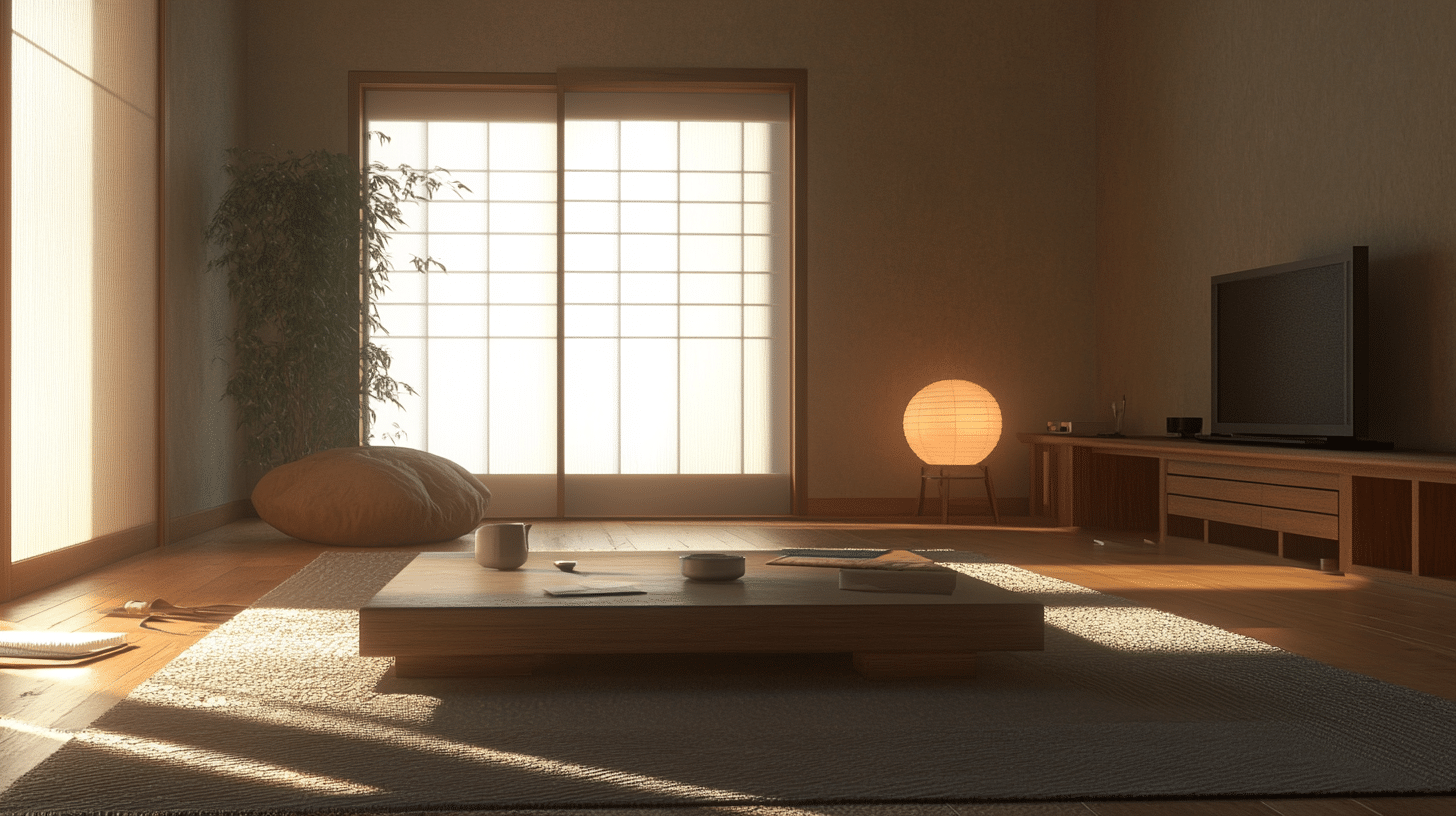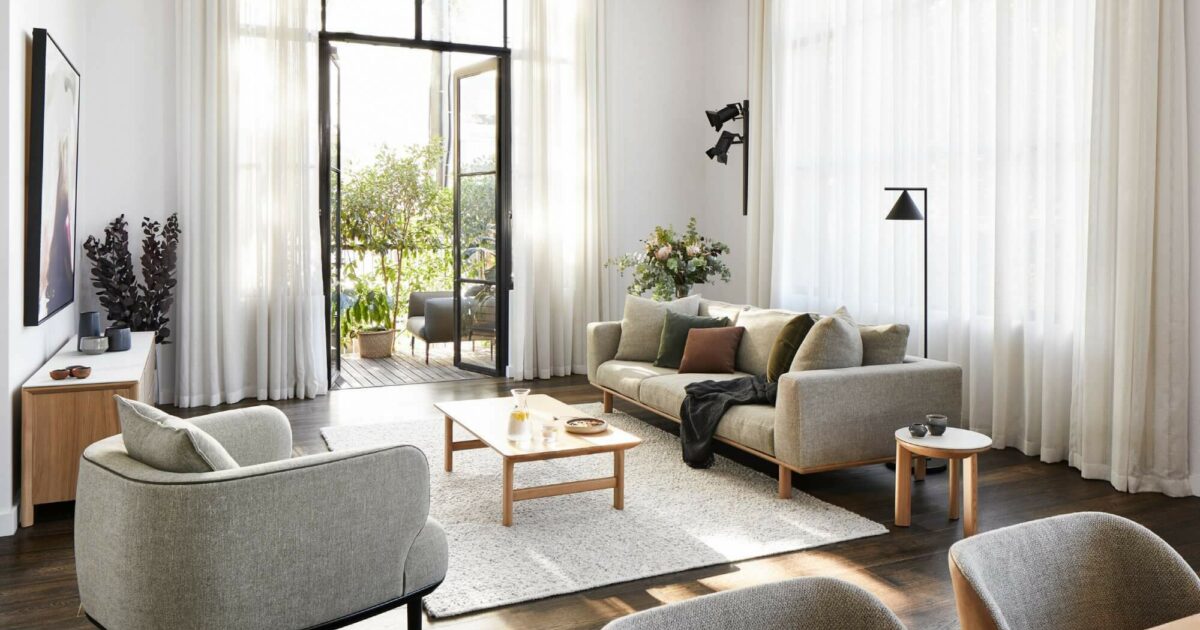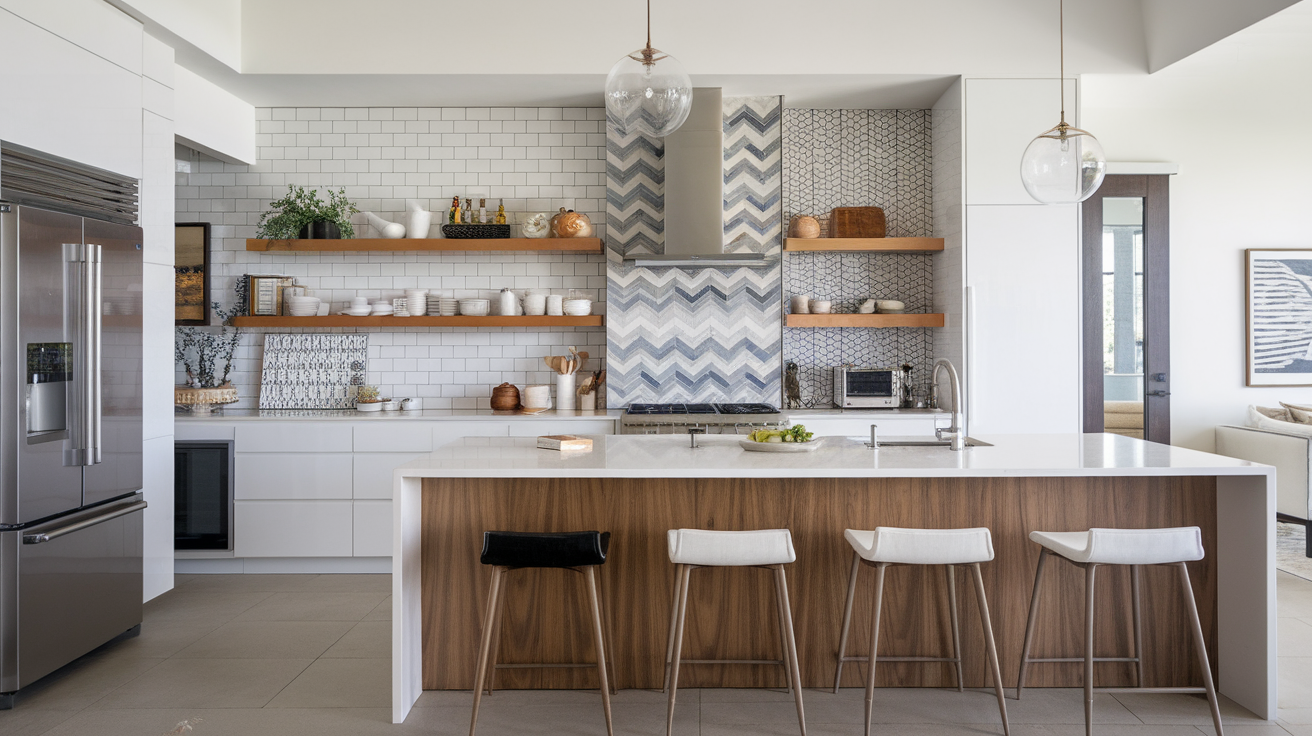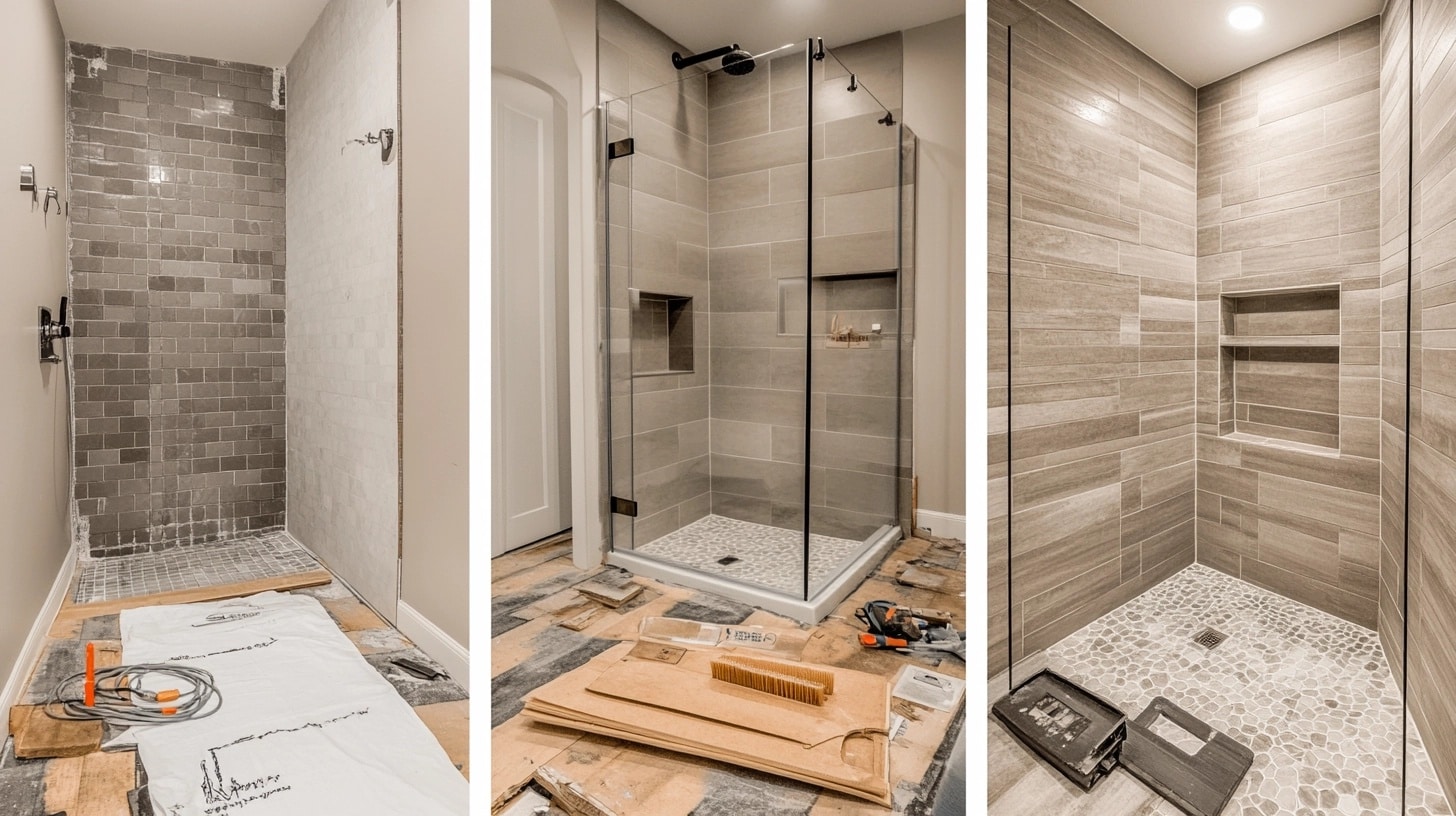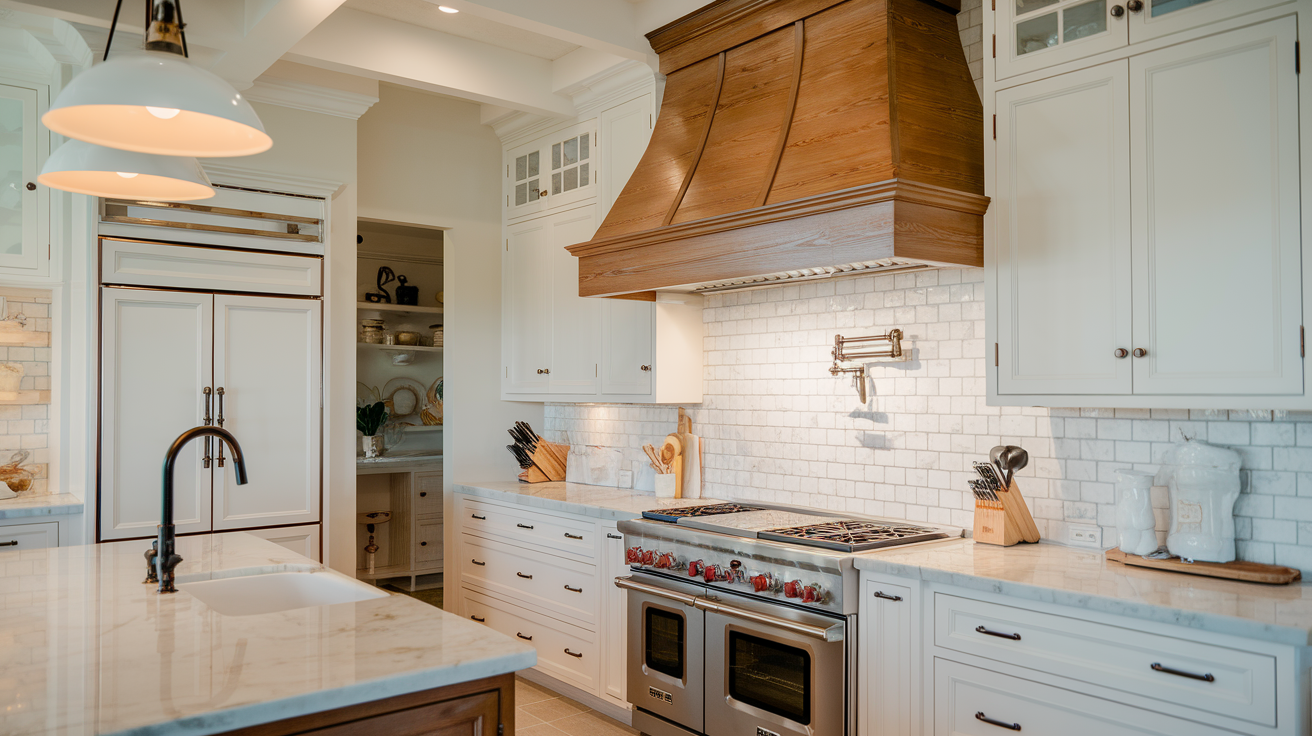Guide to Japanese Living Room Design
Living rooms often lack a sense of calm and harmony, leaving us feeling unsettled in our own homes.
Japanese design principles offer a solution, bringing balance and tranquility to your living space.
This guide will show you how to apply these concepts to create a Japanese-inspired living room that’s both functional and serene.
We’ll explore key elements of Japanese design, including minimalism, natural materials, and harmony with nature.
You’ll learn practical tips for furniture selection, color schemes, and decorative touches that capture the essence of Japanese aesthetics.
By the end of this guide, you’ll have the knowledge to transform your living room into a peaceful retreat that reflects the simplicity and beauty of Japanese design.
25 Japanese Living Room Design Elements to Consider
1. Tatami Mats
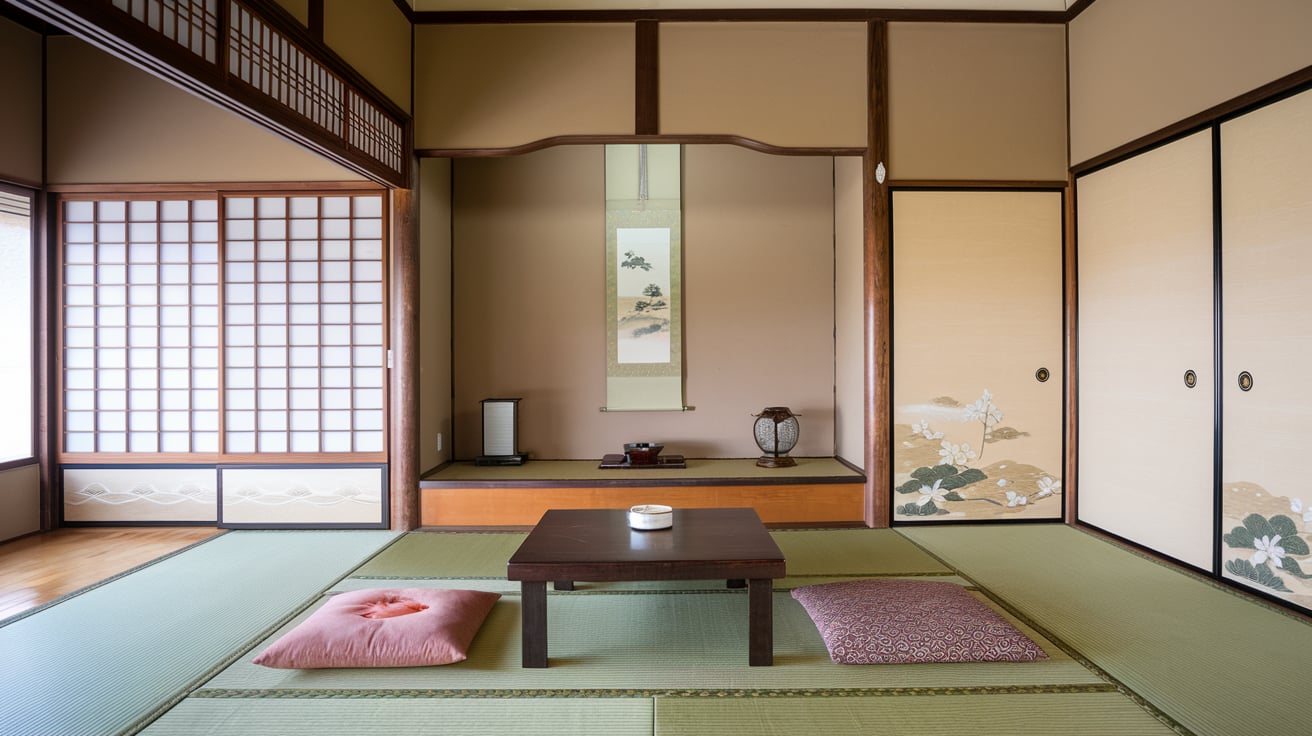
Bring a touch of tradition to your living room with tatami mats. These woven straw mats offer a soft, natural flooring option that’s comfortable to sit or walk on.
They also provide a distinct aroma and texture, adding depth to your space. Tatami mats can be used to cover the entire floor or as area rugs.
- DIY Idea: Create a faux tatami area using interlocking foam tiles covered with woven grass mats
- Budget-Friendly Tip: Use bamboo rugs as an affordable alternative to authentic tatami
- Styling Tip: Add a low wooden table and floor cushions for a complete look
2. Low-Seating Sofa
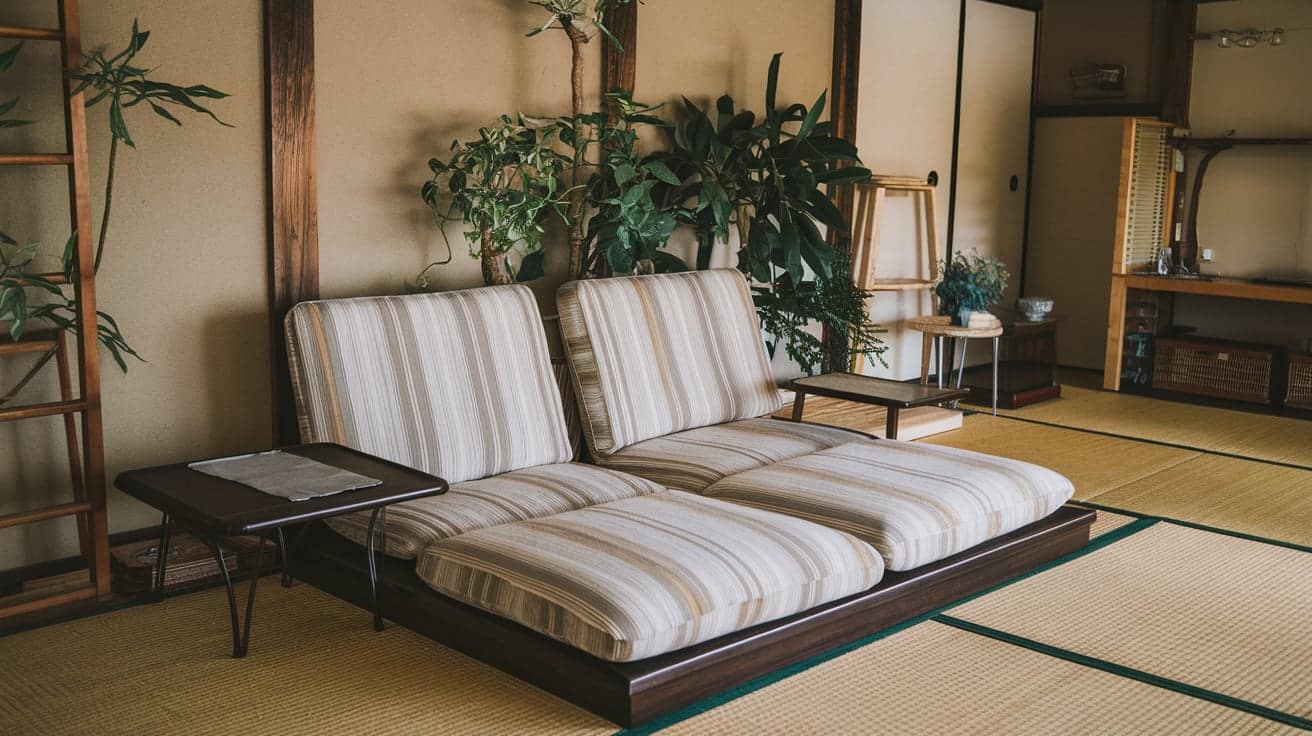
Embrace the Japanese style with a low-seating sofa. These pieces sit closer to the ground, creating a cozy and intimate atmosphere.
They help maintain clean lines and open sight lines, making your room feel more spacious. Low sofas often come in simple designs that fit well with minimalist decor.
- DIY Idea: Transform an old mattress into a floor sofa by adding a sturdy base and stylish cover
- Budget-Friendly Tip: Look for secondhand low-profile futons or daybeds
- Styling Tip: Pair with slim floor lamps and small side tables for a cohesive look
3. Shikibuton Seating
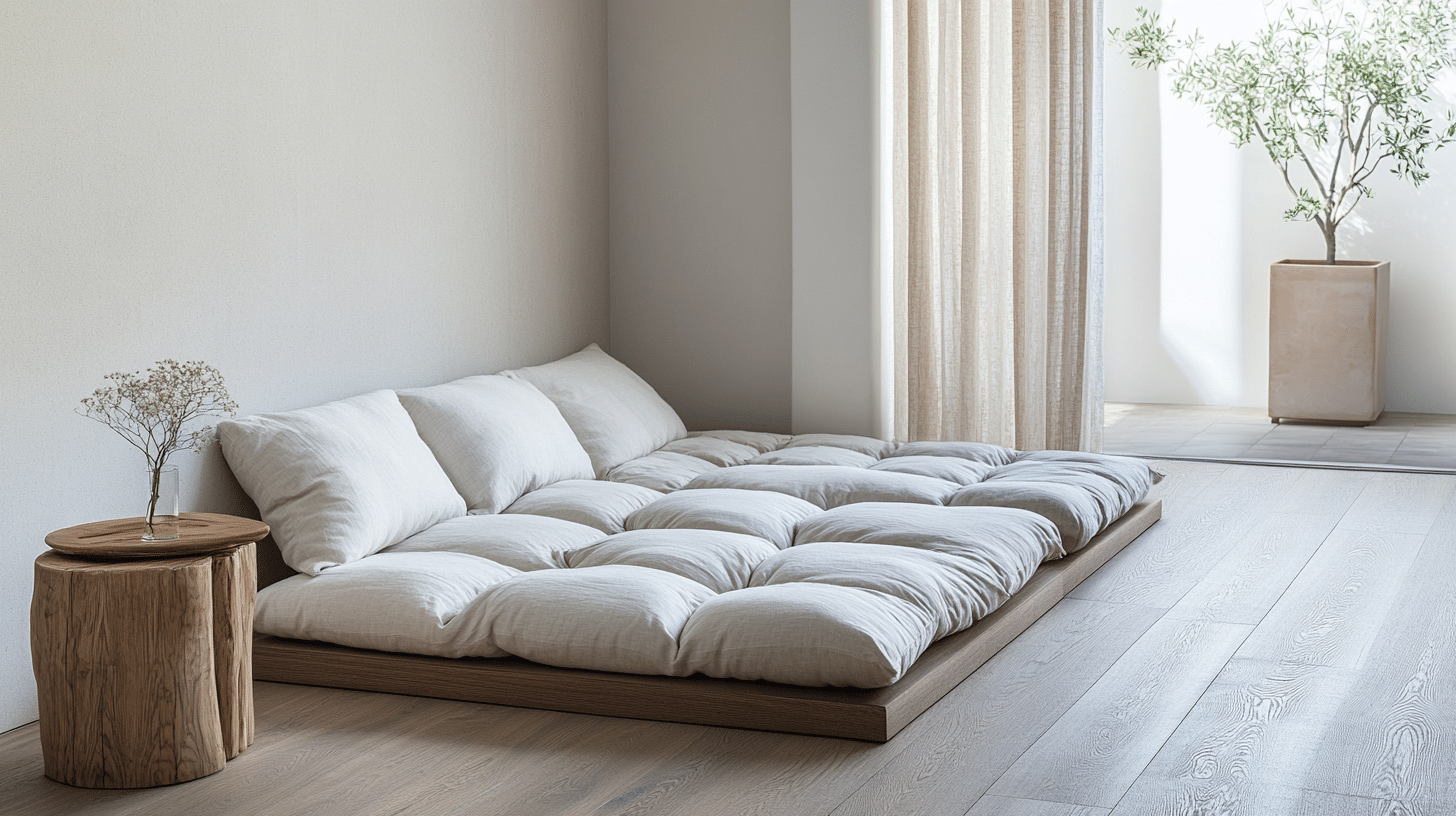
Consider shikibuton for flexible seating. These thin mattresses can be placed directly on the floor or tatami mats, offering a versatile seating solution.
They’re easy to store when not in use, freeing up space in your living room. Shikibuton come in various sizes and can be layered for extra comfort. They’re perfect for lounging, reading, or hosting guests.
- DIY Idea: Make your own shikibuton using foam padding and durable fabric
- Budget-Friendly Tip: Use thick quilts or blankets as temporary floor seating
- Styling Tip: Layer shikibuton with textured throws and minimalist cushions
4. Neutral Color Palette
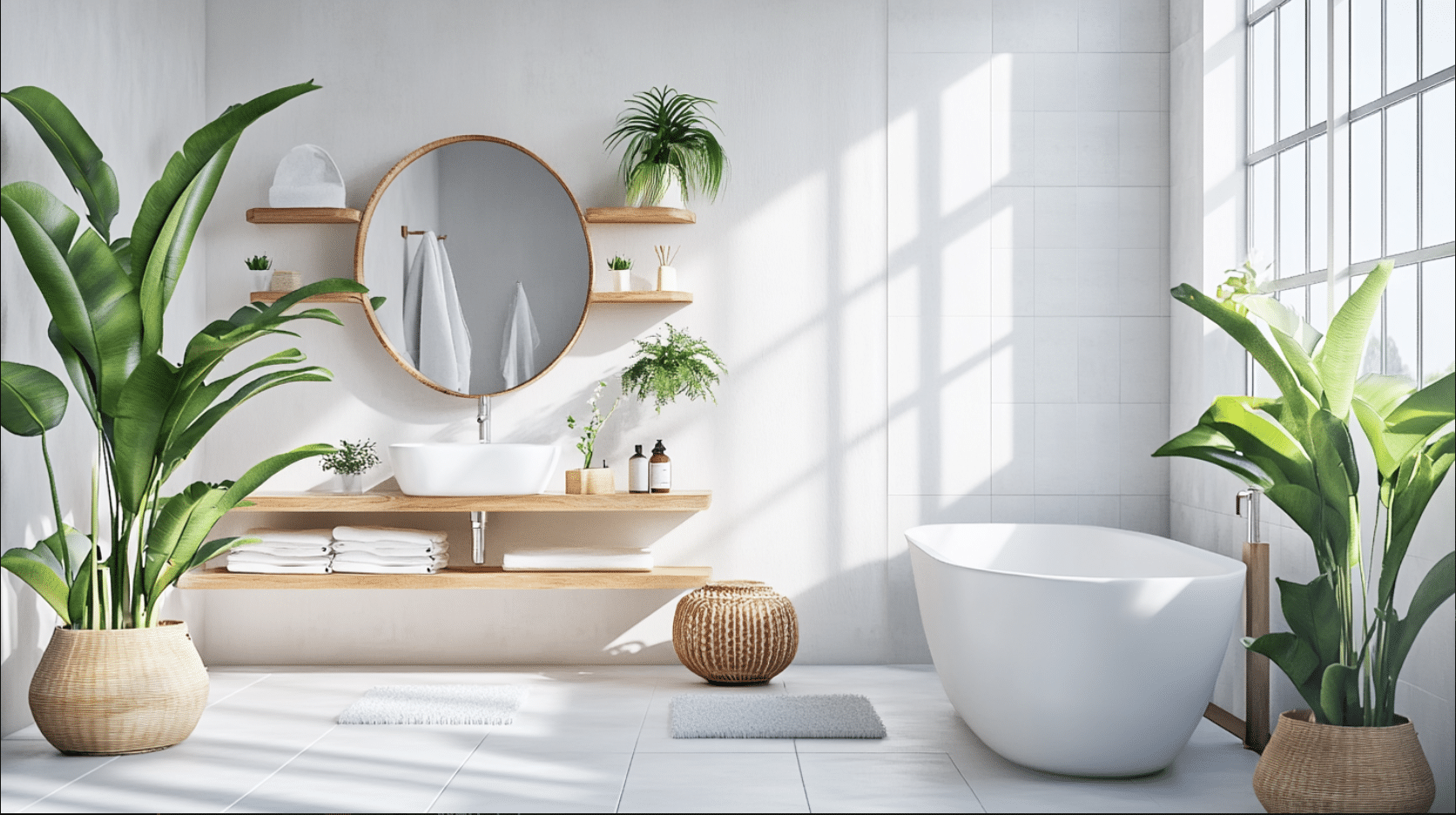
Create a calm living room with a neutral color palette. Soft beiges, whites, and light grays can make your space feel open and airy.
These colors reflect light well, brightening the room naturally. They also provide a soothing backdrop for daily activities. Use different shades and textures within this palette to add depth and interest.
- DIY Idea: Create custom wall art using neutral-toned fabrics stretched over wooden frames
- Budget-Friendly Tip: Use removable wallpaper in soft, muted tones for an easy room refresh
- Styling Tip: Add depth with different textures in the same color family, like linen curtains and wool rugs
5. Paper Lantern Lighting
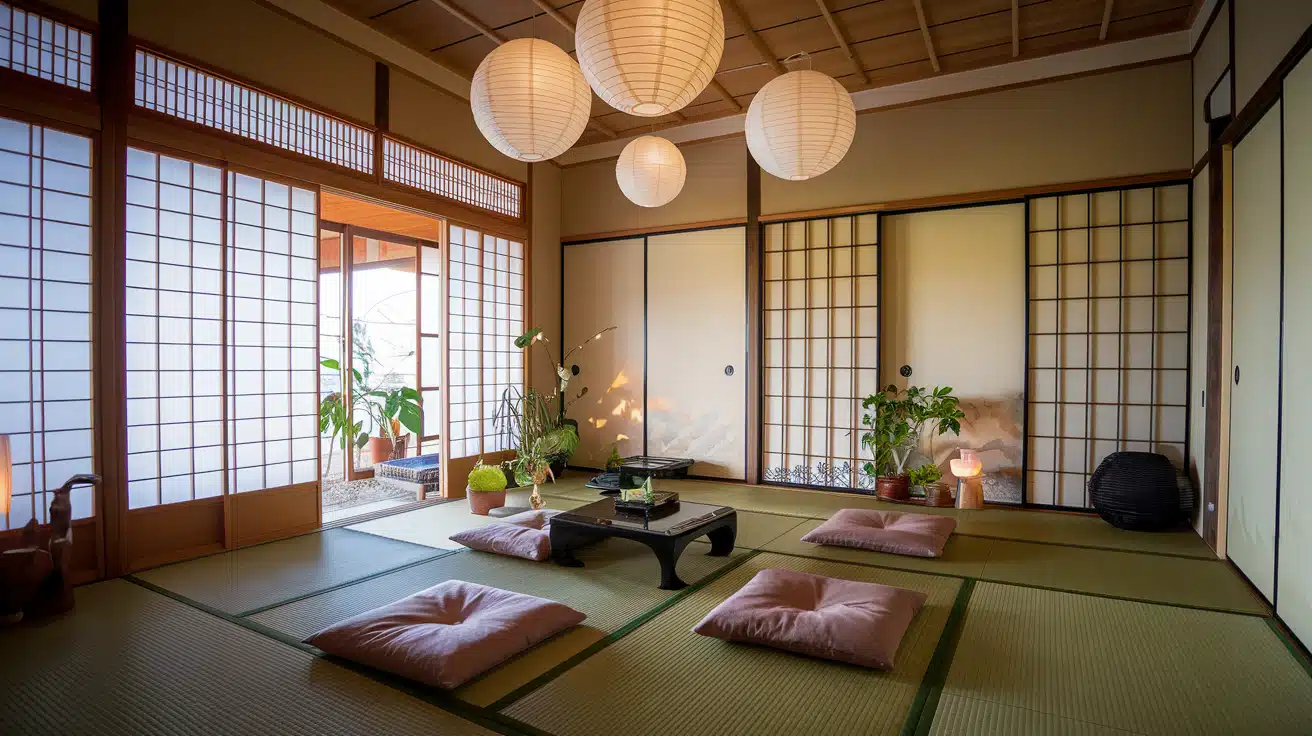
Add warmth to your living room with paper lanterns. These light fixtures cast a soft, diffused glow that creates a cozy atmosphere.
They come in various shapes and sizes, allowing you to play with different lighting levels. Paper lanterns can be hung from the ceiling or placed on side tables for subtle illumination.
- DIY Idea: Make simple paper lanterns using rice paper and bamboo hoops
- Budget-Friendly Tip: Repurpose glass jars with battery-operated candles for a lantern-like glow
- Styling Tip: Hang lanterns at varying heights for visual interest and balanced lighting
6. Shoji Screens
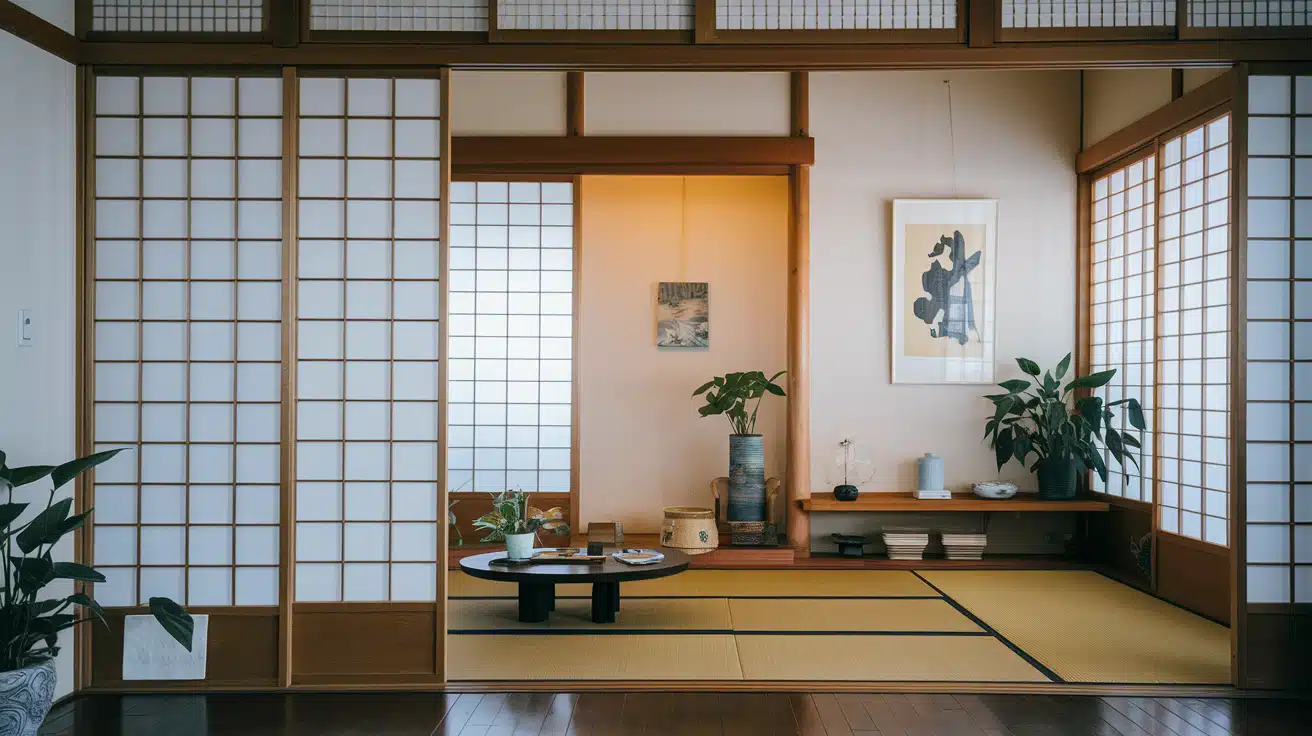
Use shoji screens to define spaces in your living room. These translucent panels allow light to filter through while providing privacy.
They’re perfect for creating cozy nooks or separating areas in an open-plan space. Shoji screens can be fixed or movable, offering flexibility in your room layout.
- DIY Idea: Construct a basic shoji screen using wooden frames and translucent paper or fabric
- Budget-Friendly Tip: Use tension rods and sheer curtains to create room dividers
- Styling Tip: Place potted plants behind shoji screens for subtle, natural shadows
7. Minimal Furniture
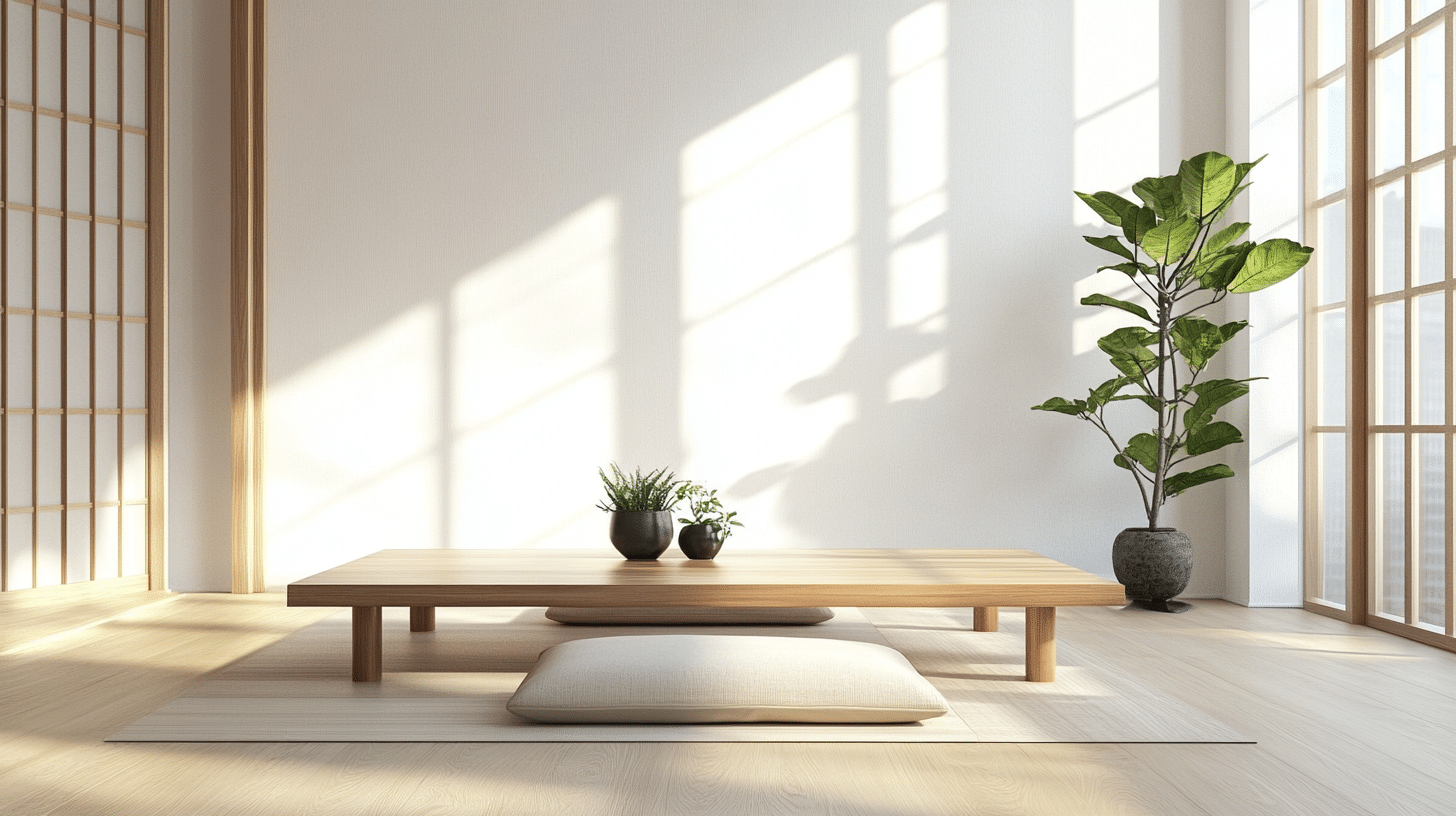
Keep your living room uncluttered with minimal furniture. Choose pieces that serve multiple purposes to maximize functionality without crowding the space.
A low table can double as a dining surface and work area. Floor cushions provide extra seating when needed and can be easily stored. Focus on quality over quantity, selecting well-crafted items that will last.
- DIY Idea: Build a low, multifunctional table using reclaimed wood or bamboo
- Budget-Friendly Tip: Opt for versatile pieces like storage ottomans that serve multiple purposes
- Styling Tip: Choose one statement piece, like a unique floor lamp, to anchor the minimal space
8. Indoor Bonsai Trees
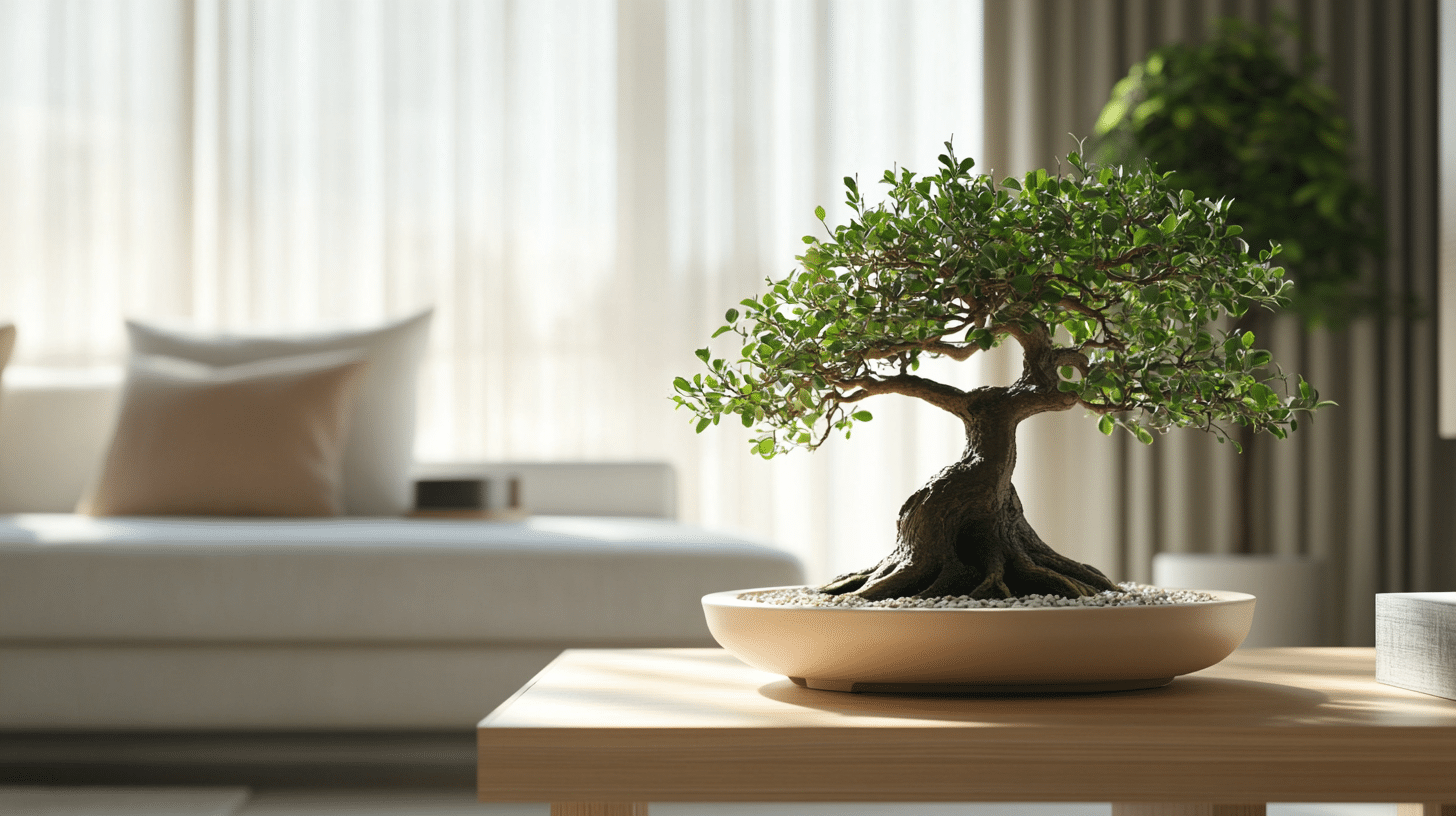
Bring nature indoors with bonsai trees. These miniature trees add a living focal point to your living room, creating a connection to the outdoors.
Place them on low tables or shelves where they can be easily seen and appreciated. Bonsai require regular care, which can be a meditative practice. Choose species that thrive indoors, like ficus or jade.
- DIY Idea: Create a faux bonsai using wire and artificial foliage for a low-maintenance option
- Budget-Friendly Tip: Start with small, young bonsai trees and learn to shape them yourself
- Styling Tip: Place bonsai on a simple wooden stand to elevate its presence in the room
9. Natural Wood Furniture
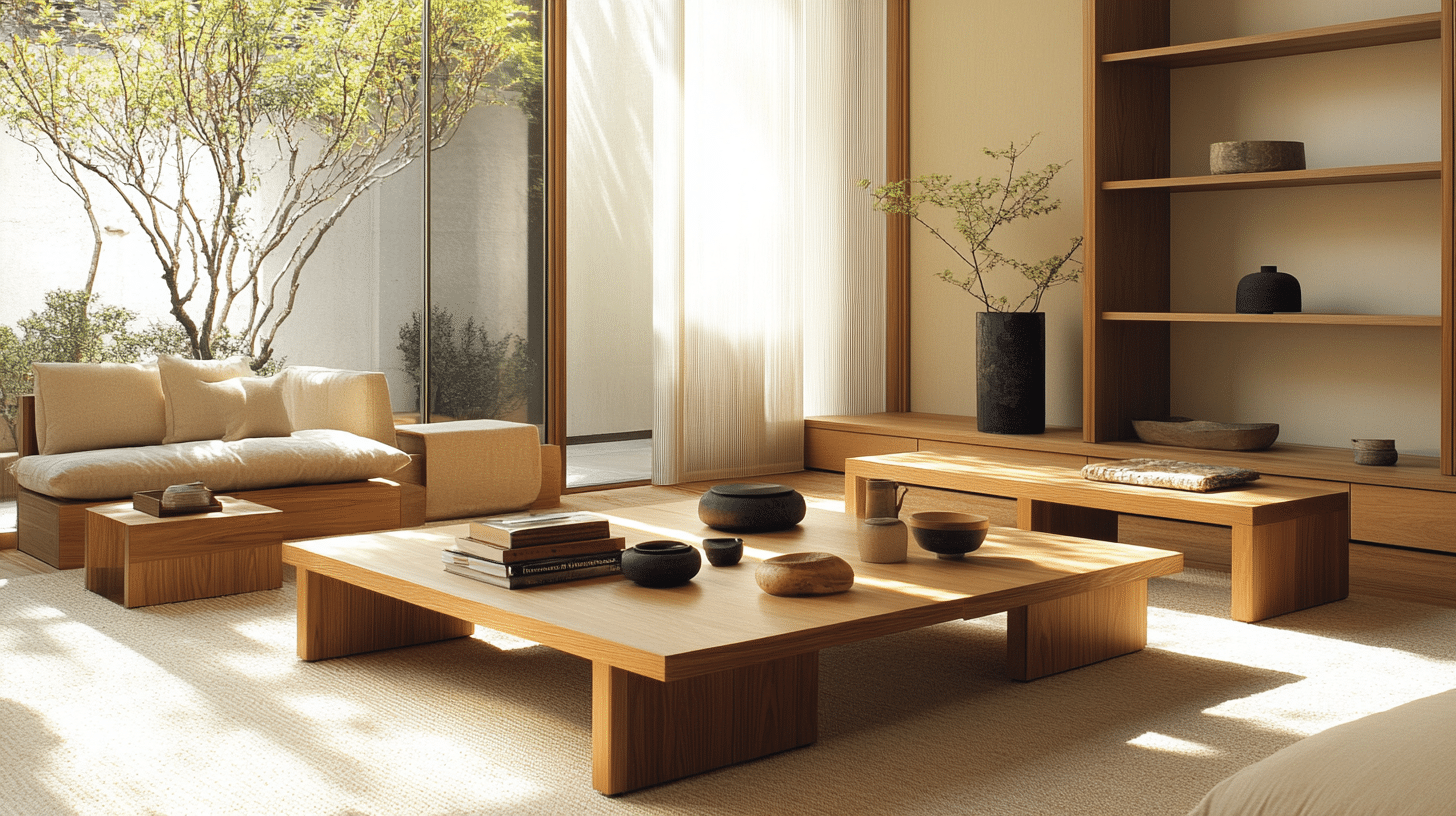
Incorporate natural wood tones in your furniture to add warmth and texture to your living room. Look for pieces with simple lines and smooth finishes that showcase the wood’s natural grain.
A low wooden table or shelving unit can serve as a centerpiece. Choose lighter woods like pine or maple for a brighter feel, or darker woods like walnut for a more grounded look.
- DIY Idea: Refinish old furniture with natural wood stains to achieve a warm, organic look
- Budget-Friendly Tip: Look for unfinished wood pieces at thrift stores and finish them yourself
- Styling Tip: Mix different wood tones for a layered, natural aesthetic
10. Zen-Inspired Wall Art

Enhance your living room with zen-inspired wall art. Look for pieces that feature simple, abstract designs or nature themes. Minimalist landscapes or black-and-white prints work well.
Keep the number of art pieces minimal to maintain a sense of space and tranquility. Consider hanging a single large piece as a focal point, or create a small, balanced grouping.
- DIY Idea: Create minimalist ink paintings using simple brushstrokes on rice paper
- Budget-Friendly Tip: Frame natural elements like leaves or branches for organic wall decor
- Styling Tip: Hang art asymmetrically to create visual interest while maintaining balance
11. Monochromatic Decor

Create a sleek, modern look with monochromatic decor. A black-and-white color scheme provides a clean, uncluttered feel. Use varying shades and textures within this palette to add depth.
Incorporate small pops of color through plants or a single accent piece for visual interest. This approach allows architectural features and furnishings to stand out. It’s also easy to maintain and update over time.
- DIY Idea: Spray paint various decorative items in shades of black or white for a cohesive look
- Budget-Friendly Tip: Use white bedsheets as slipcovers for existing furniture
- Styling Tip: Add texture through patterns and materials to prevent the space from feeling flat
12. Ikebana (Flower Arrangements)
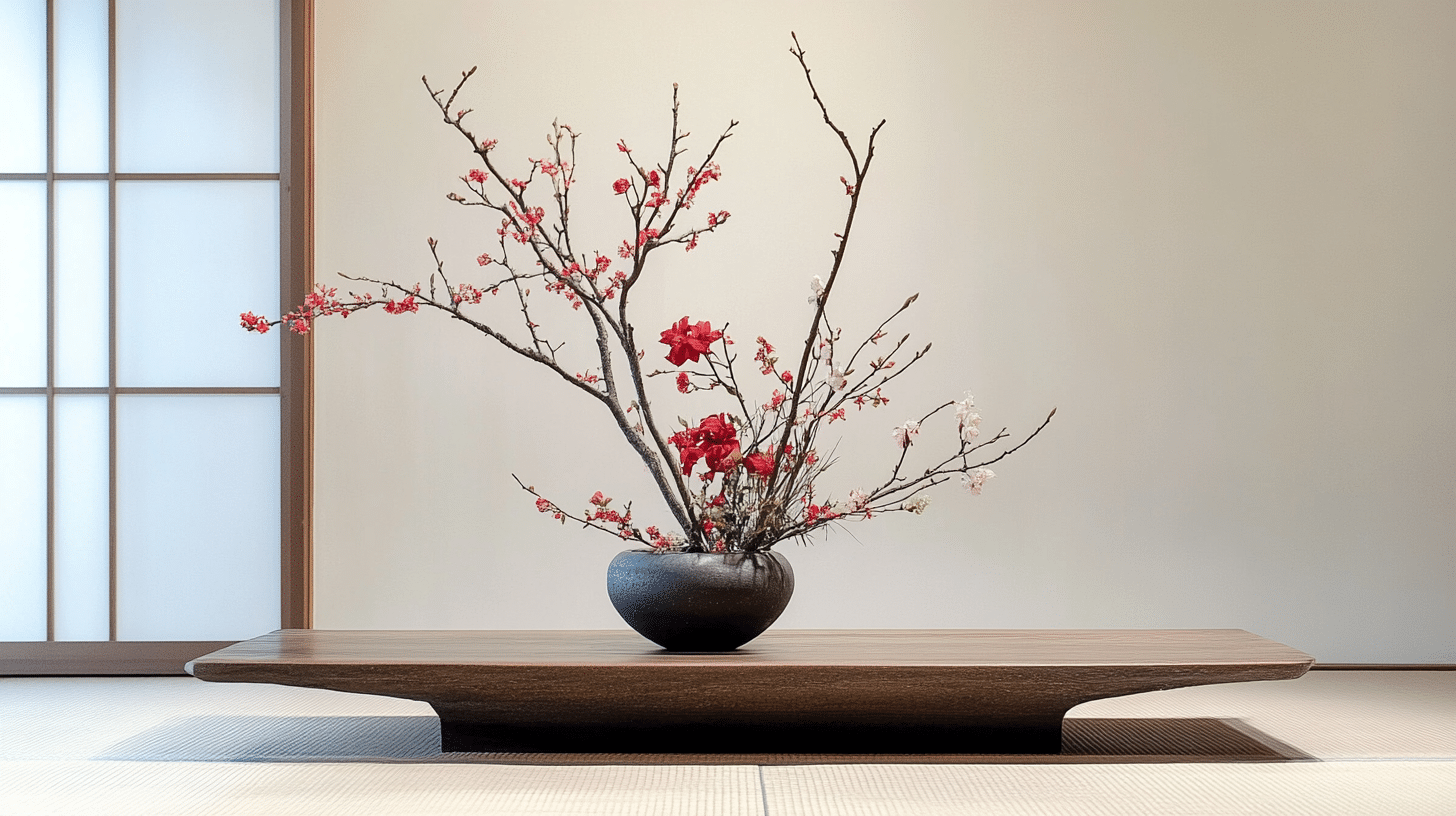
Bring life and seasonal beauty to your living room with ikebana. These Japanese flower arrangements focus on simplicity and balance. Use a low, wide vase and just a few carefully chosen stems.
Place your ikebana on a low table or in a tokonoma alcove if you have one. Change your arrangement regularly to reflect the seasons.
- DIY Idea: Learn basic ikebana principles to create your own arrangements with local flora
- Budget-Friendly Tip: Use branches, leaves, and a single flower for a minimalist arrangement
- Styling Tip: Place arrangements in simple, monochromatic vases to highlight the flora
13. Chabudai (Low Tables)
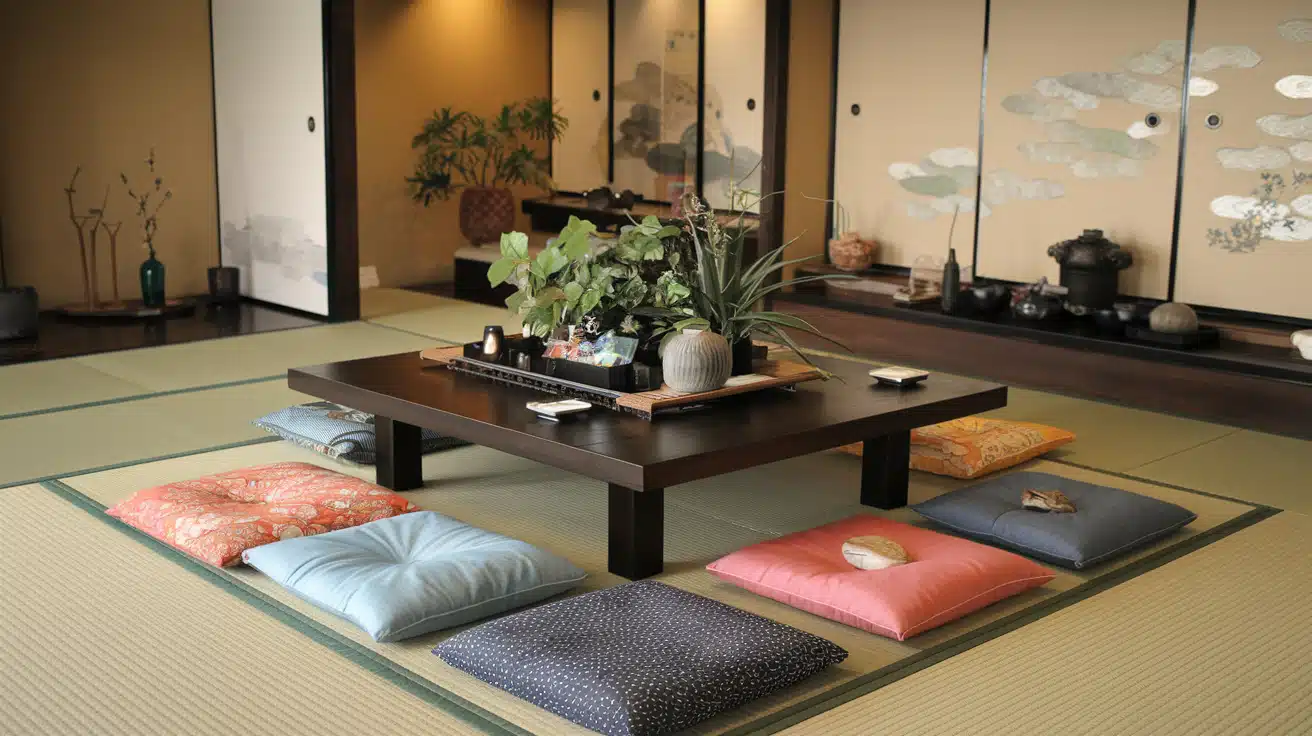
Incorporate a chabudai for versatile, floor-level use. These low tables are perfect for dining, tea ceremonies, or as a central piece in your living room.
Choose a simple wooden design that complements your other furnishings. When not in use, a chabudai can serve as a display surface for decorative items or plants.
- DIY Idea: Repurpose an old coffee table by shortening its legs
- Budget-Friendly Tip: Look for secondhand side tables that can be used as chabudai
- Styling Tip: Pair with floor cushions in complementary colors for a cohesive dining area
14. Japanese Folding Fans
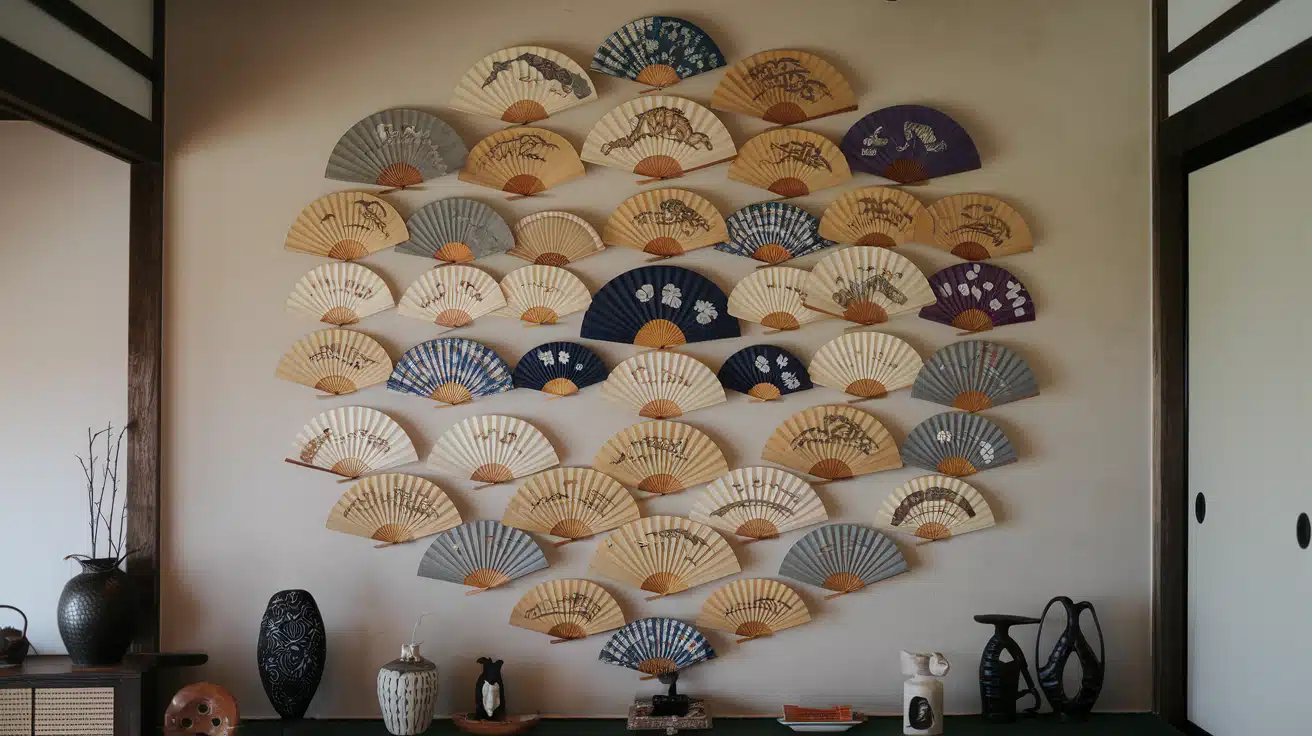
Decorate your walls with Japanese folding fans for a touch of artistry. Select fans with beautiful patterns or painted scenes. Choose fans in colors that complement your room’s palette.
This decorative element adds texture and visual interest while celebrating Japanese craftsmanship. It’s an affordable way to fill wall space and add a cultural touch to your living room.
- DIY Idea: Decorate plain paper fans with minimalist designs using acrylic paint
- Budget-Friendly Tip: Look for fans at Asian markets or online for affordable options
- Styling Tip: Arrange fans in a circular pattern for a stunning wall display
15. Legless Chairs (Zaisu)
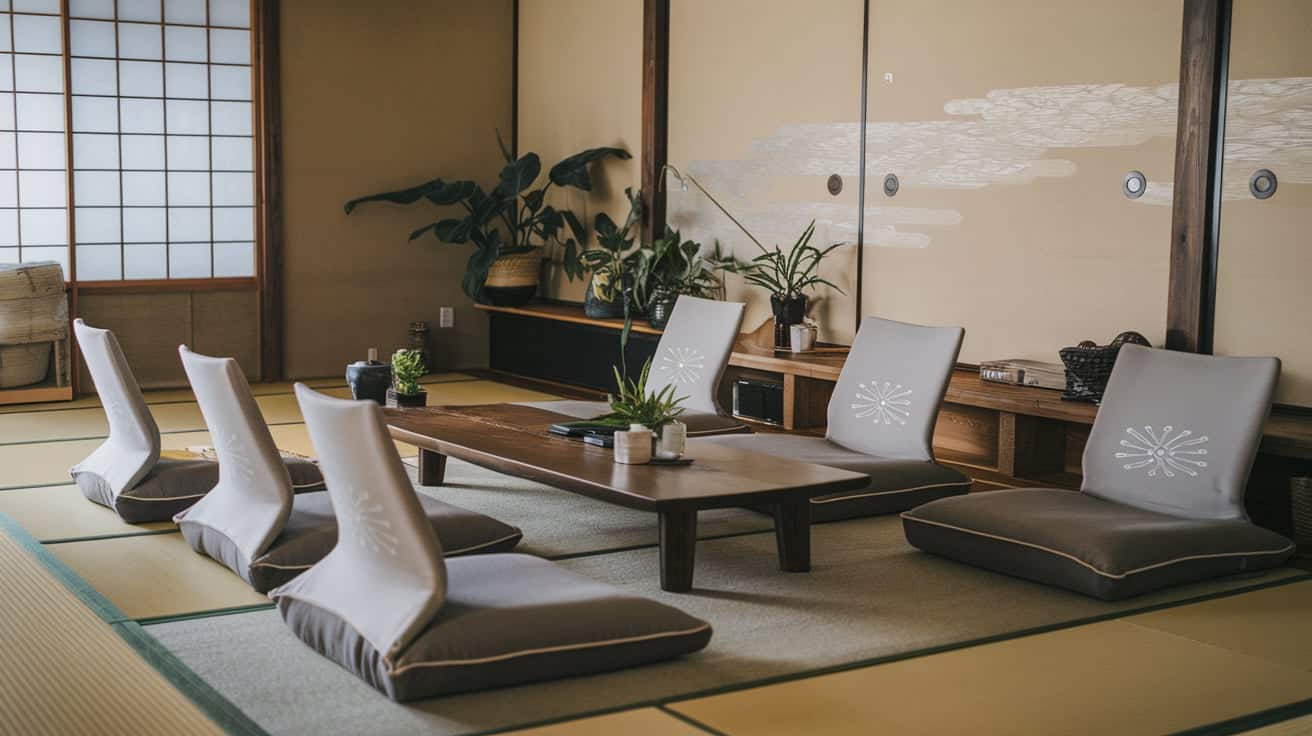
Enhance comfort while maintaining a low profile with zaisu chairs. These legless chairs provide back support for extended floor sitting.
Zaisu are perfect around a low table for dining or relaxing. When not in use, they can be stacked or stored flat, saving space. They offer a great balance between traditional floor seating and modern comfort needs.
- DIY Idea: Remove legs from old dining chairs and add comfortable padding
- Budget-Friendly Tip: Use backrest pillows as a simple alternative to zaisu chairs
- Styling Tip: Choose zaisu with subtle patterns to add visual interest to the floor seating area
16. Japanese Calligraphy Art
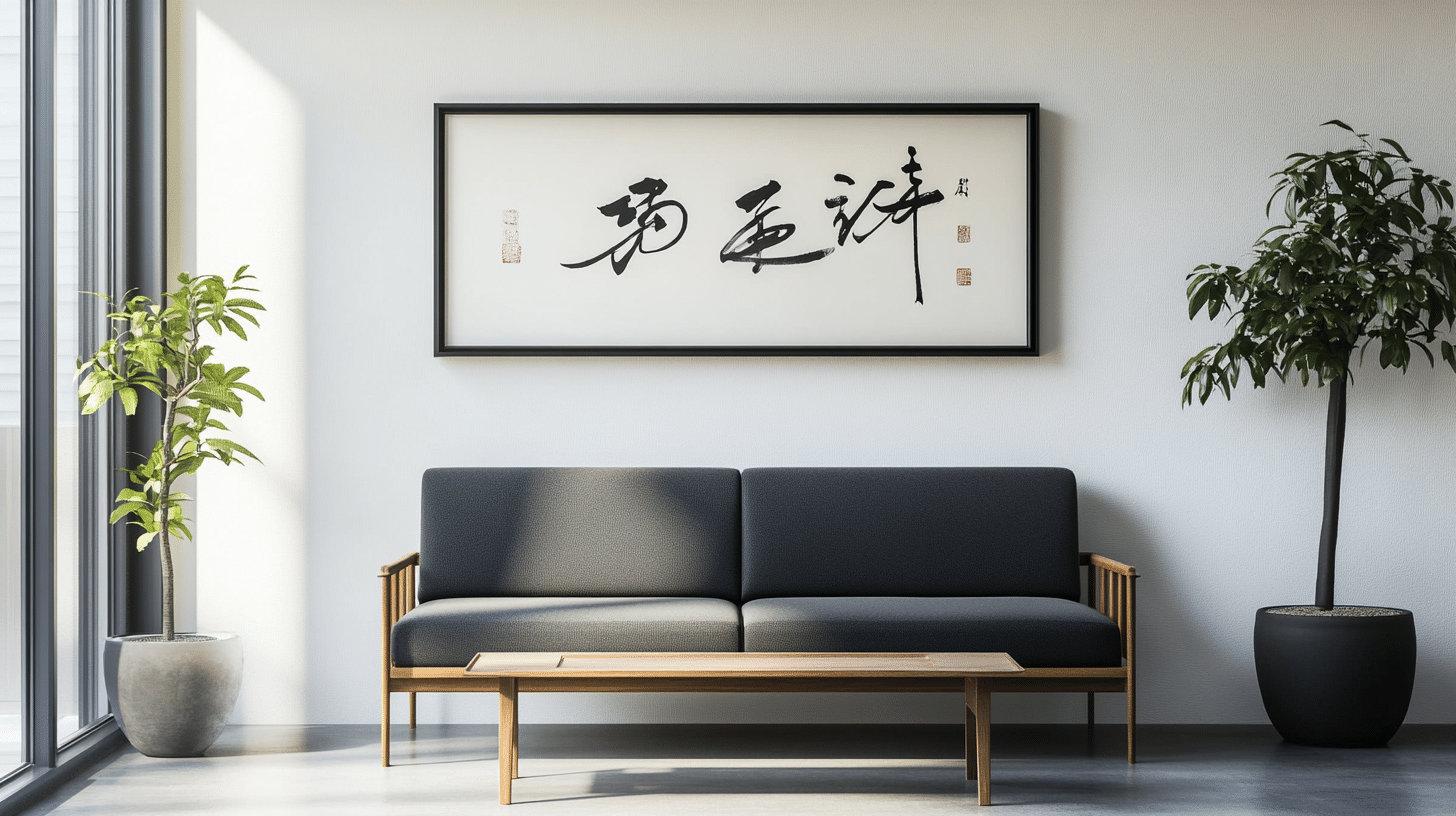
Make a bold statement with Japanese calligraphy art. Choose a large piece featuring a single character or short phrase to serve as a focal point. The stark contrast of black ink on white paper creates visual impact.
Look for pieces with balanced composition and fluid brushstrokes. This art form adds cultural depth and a meditative quality to your living room.
- DIY Idea: Learn basic calligraphy and create your own large-scale art on rice paper
- Budget-Friendly Tip: Use fabric paint on a plain white canvas for a calligraphy-inspired piece
- Styling Tip: Frame your calligraphy art in a simple, thin black frame for a striking contrast
17. Wood Carvings
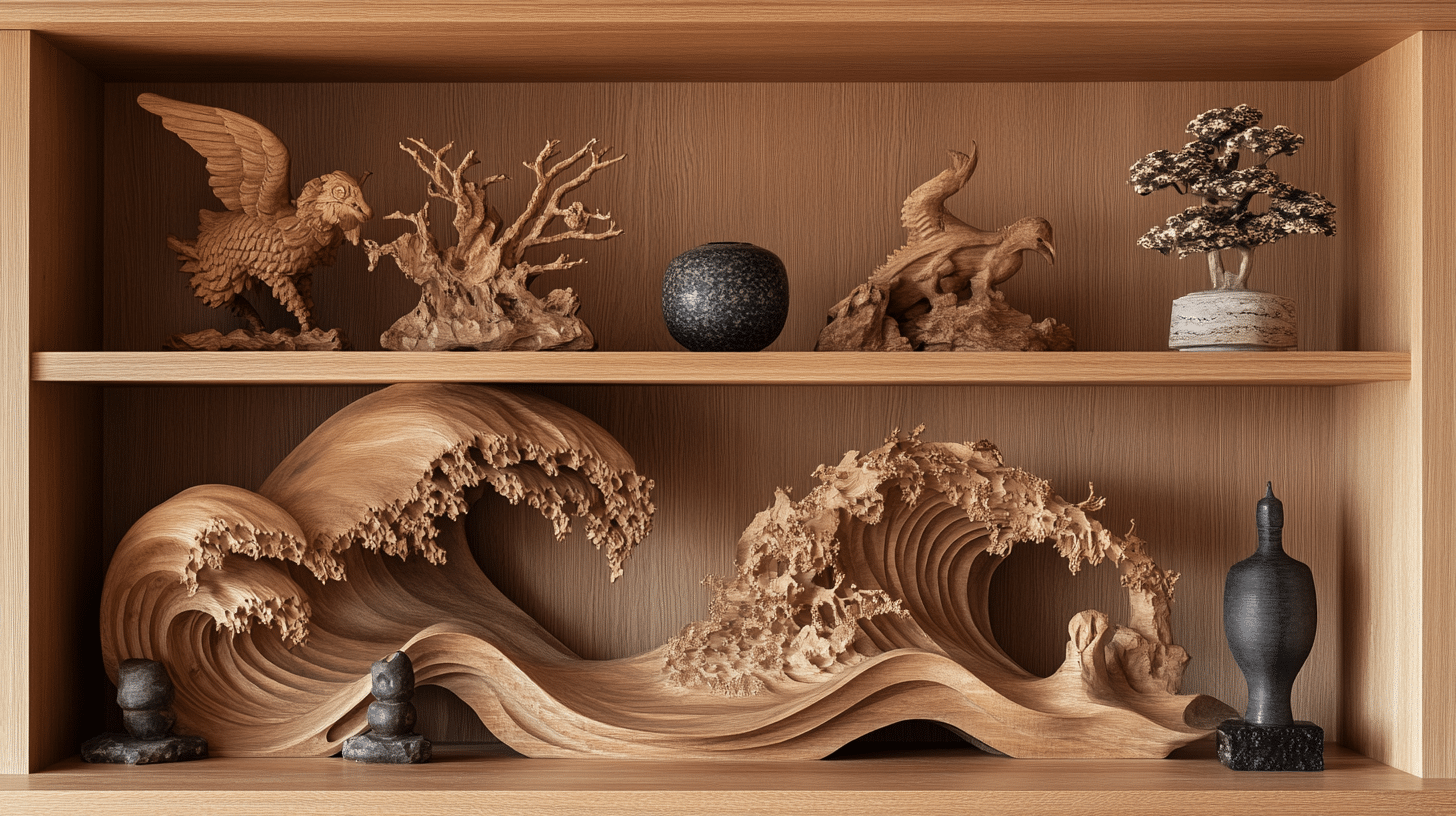
Introduce texture and craftsmanship with wood carvings. Select pieces that showcase the natural grain and color of the wood. Look for carvings of nature motifs like waves, mountains, or animals.
Place smaller carvings on shelves or tables as accents. Larger pieces can stand alone as sculptural elements. Wood carvings add warmth and a connection to nature, enhancing the organic feel of your space.
- DIY Idea: Try your hand at simple wood carving using soft woods like basswood
- Budget-Friendly Tip: Look for wooden figurines at thrift stores and refinish them
- Styling Tip: Group carvings in odd numbers for a visually pleasing arrangement
18. Ceramic Vases
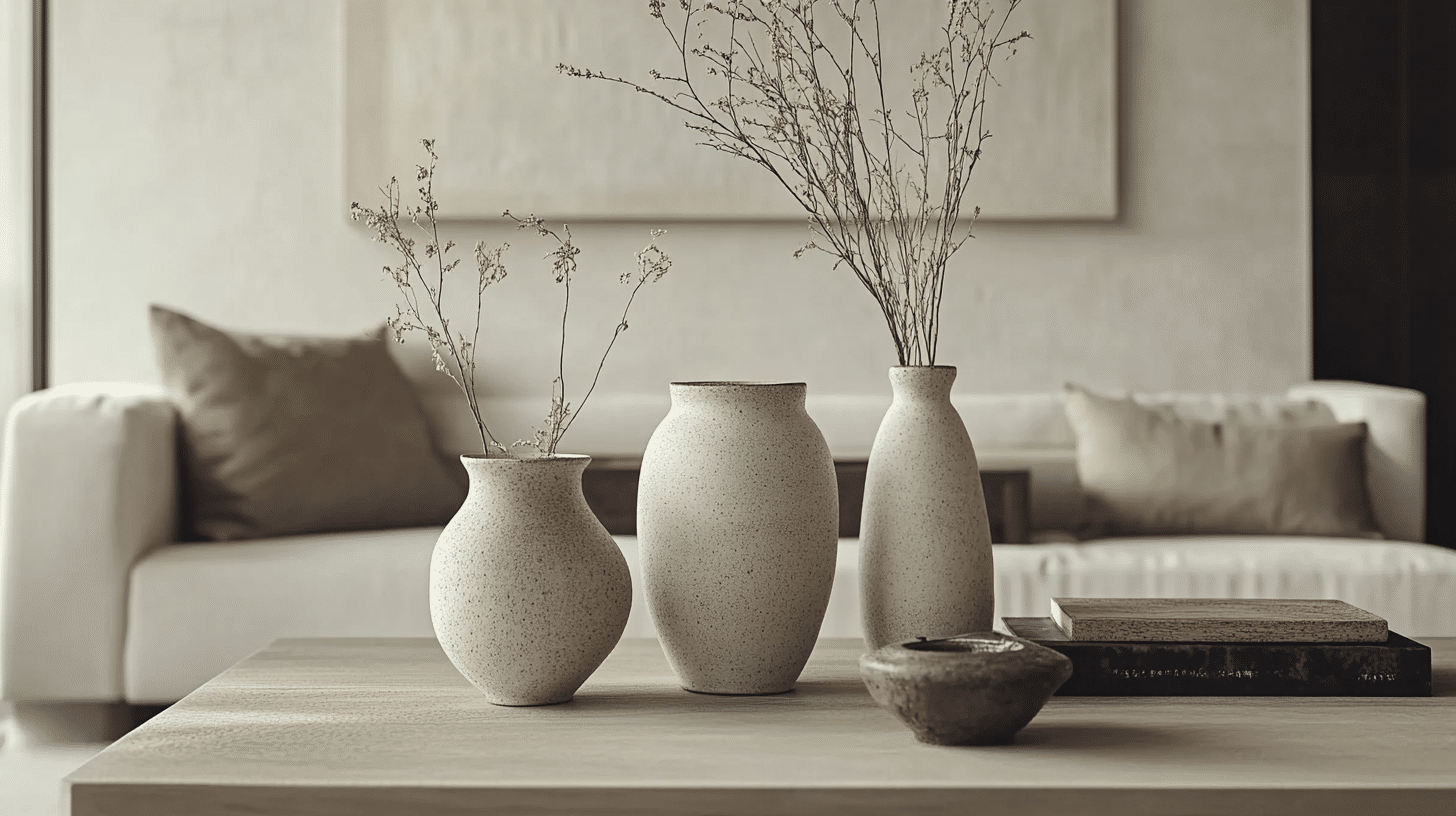
Enhance your living room with handcrafted ceramic vases. Choose pieces with simple shapes and subtle glazes that complement your color scheme.
Look for vases with interesting textures or slight imperfections that highlight their handmade quality. Use them to display simple flower arrangements or as standalone decorative items.
- DIY Idea: Paint plain terracotta pots with matte paint for a handcrafted ceramic look
- Budget-Friendly Tip: Scour local flea markets for unique, affordable ceramic pieces
- Styling Tip: Mix different heights and shapes while keeping colors neutral
19. Tea Set Display
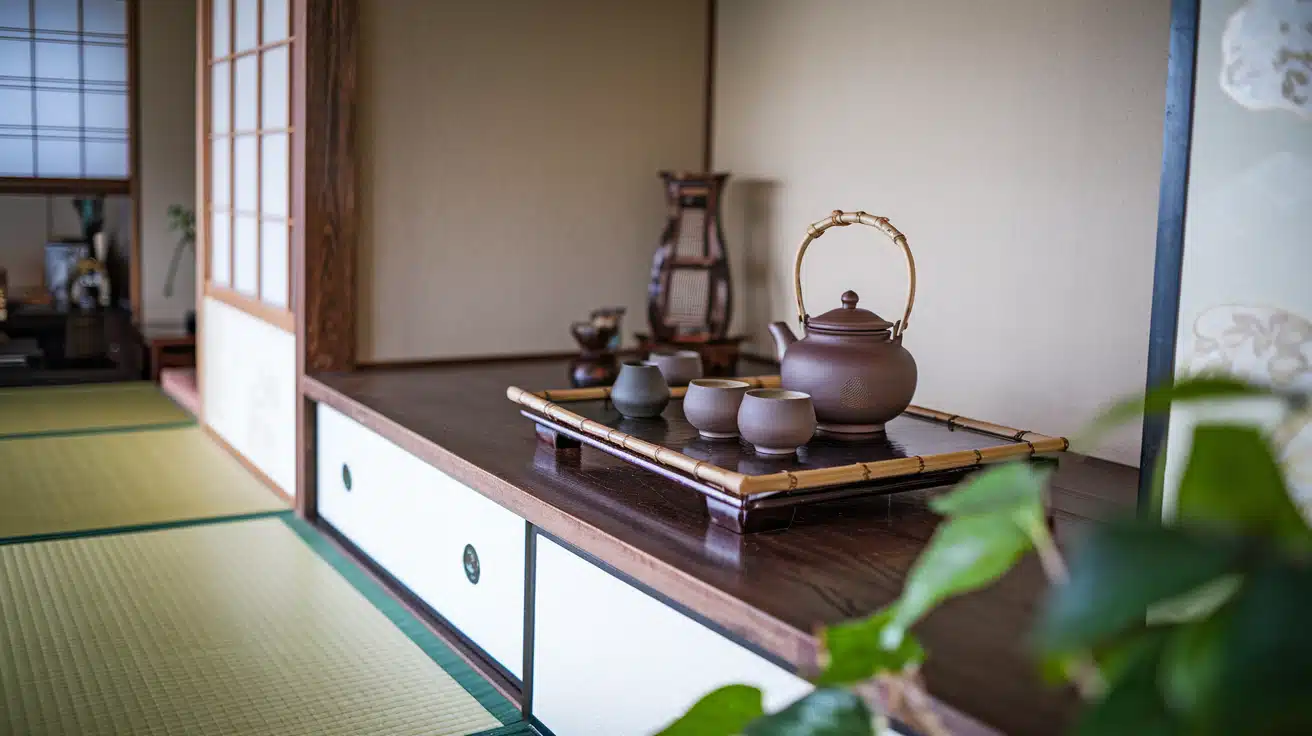
Showcase a traditional Japanese tea set to add cultural richness to your living room. Choose a set with simple, elegant lines in materials like ceramic or cast iron.
Arrange the pieces thoughtfully, perhaps on a bamboo tray. This display not only adds visual interest but also invites conversation about Japanese tea culture. It can serve as both decor and a functional item for serving tea.
- DIY Idea: Create a custom tea tray using a wooden board and small tiles
- Budget-Friendly Tip: Start with a basic tea set and add pieces over time
- Styling Tip: Arrange the tea set on a low shelf with a simple scroll or fan backdrop
20. Origami Art
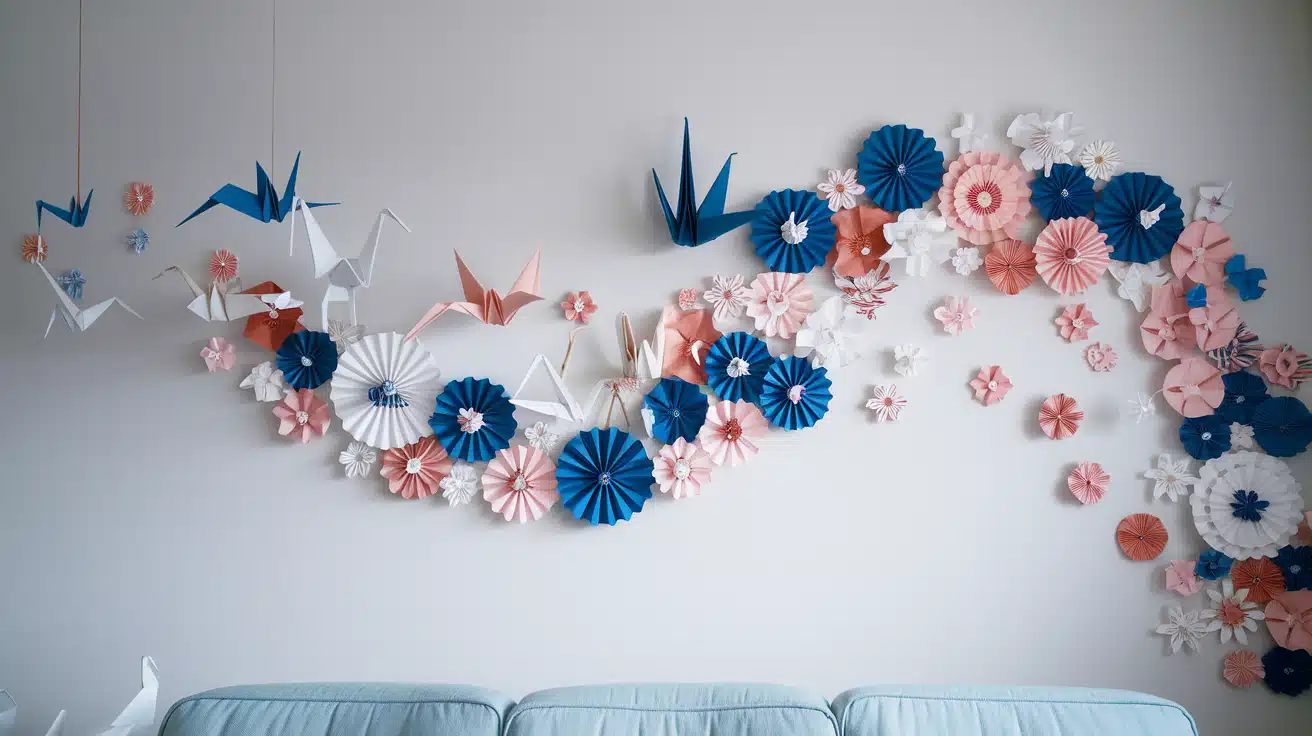
Create a unique wall display using handmade origami. Craft or source a collection of origami pieces in various shapes and sizes. Arrange them in a geometric pattern or flowing design on a plain wall.
Choose paper in colors that complement your room’s palette. This DIY art project adds a personal touch and showcases the beauty of paper folding.
- DIY Idea: Fold multiple origami cranes and hang them in a cascading pattern
- Budget-Friendly Tip: Use pages from old books or magazines for an eclectic look
- Styling Tip: Create a focal wall by arranging origami pieces in a geometric pattern
21. Floor Cushions (Zabuton)
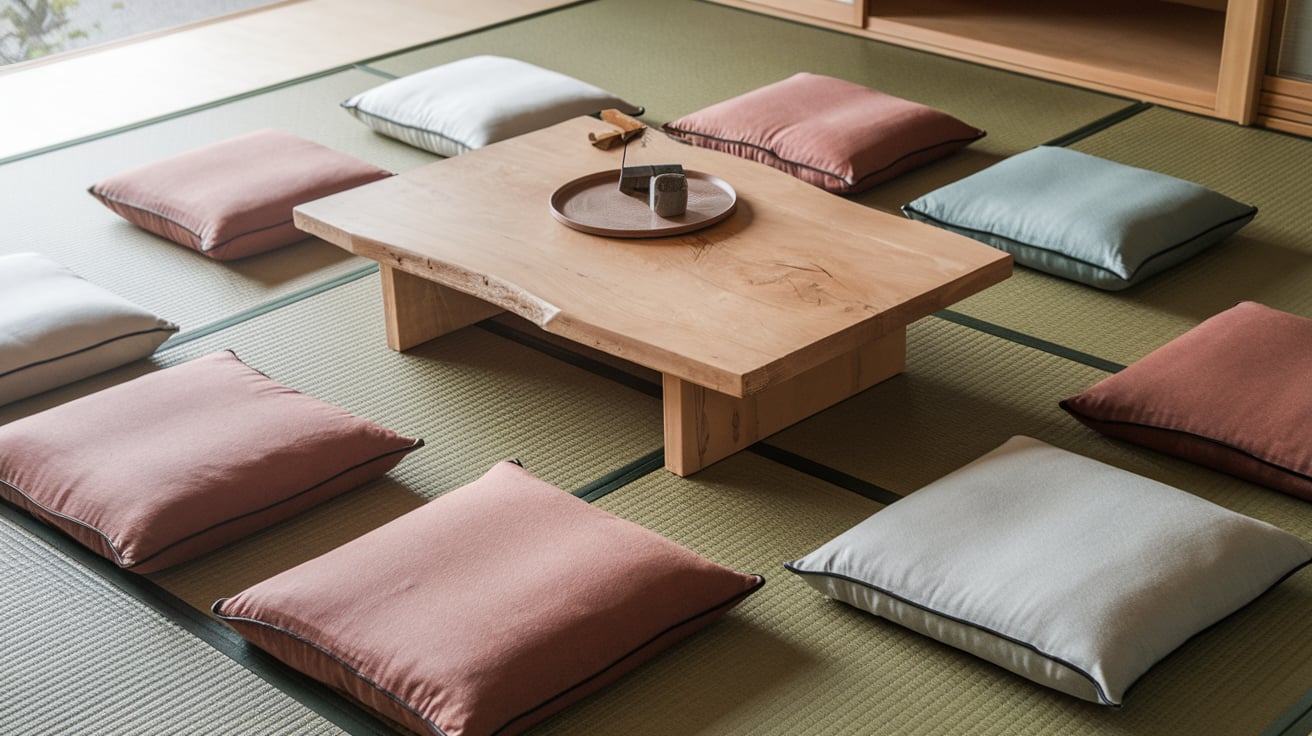
Add flexibility to your seating with zabuton floor cushions. These traditional cushions provide comfort for floor sitting. Stack them neatly when not in use to save space.
Choose cushions in colors that complement your decor. Zabuton are perfect for casual gatherings or creating cozy reading nooks. They’re also easy to move around, allowing you to change your room layout easily.
- DIY Idea: Sew simple square cushions using leftover fabric or old blankets
- Budget-Friendly Tip: Use large throw pillows as an alternative to traditional zabuton
- Styling Tip: Arrange cushions in a circular pattern for intimate gathering spaces
22. Washi Paper Lamps
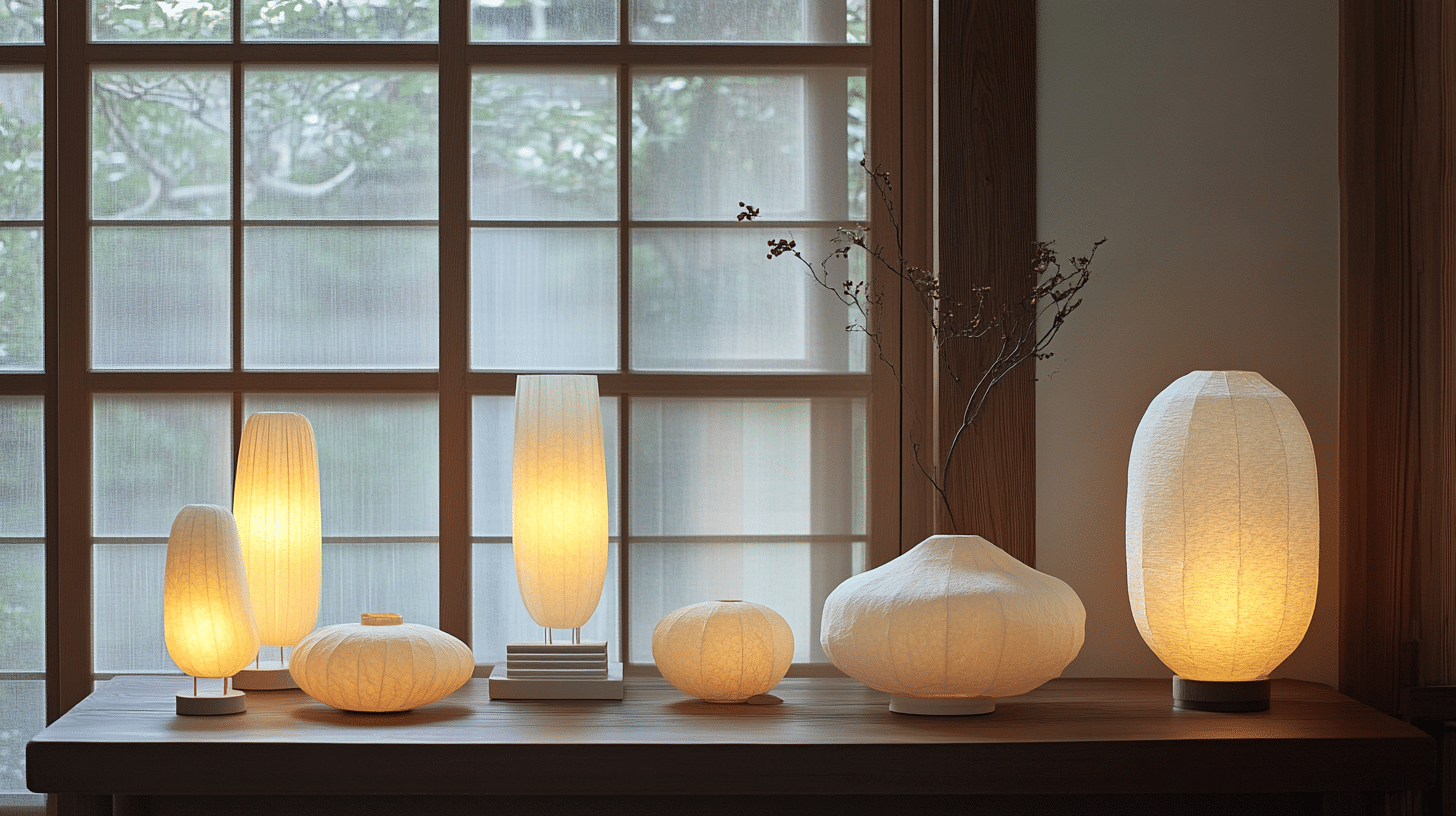
Bring soft, warm light to your living room with washi paper lamps. These lamps use traditional Japanese paper that filters light beautifully, creating a cozy atmosphere.
Choose simple designs in neutral colors to blend with your decor. The gentle glow they produce is perfect for relaxation and adds a touch of Japanese craftsmanship to your space.
- DIY Idea: Create custom lamp shades using washi paper and simple lamp frames
- Budget-Friendly Tip: Upcycle old lampshades by covering them with washi paper
- Styling Tip: Mix different shapes of washi lamps for varied lighting effects
23. Kakejiku Scrolls
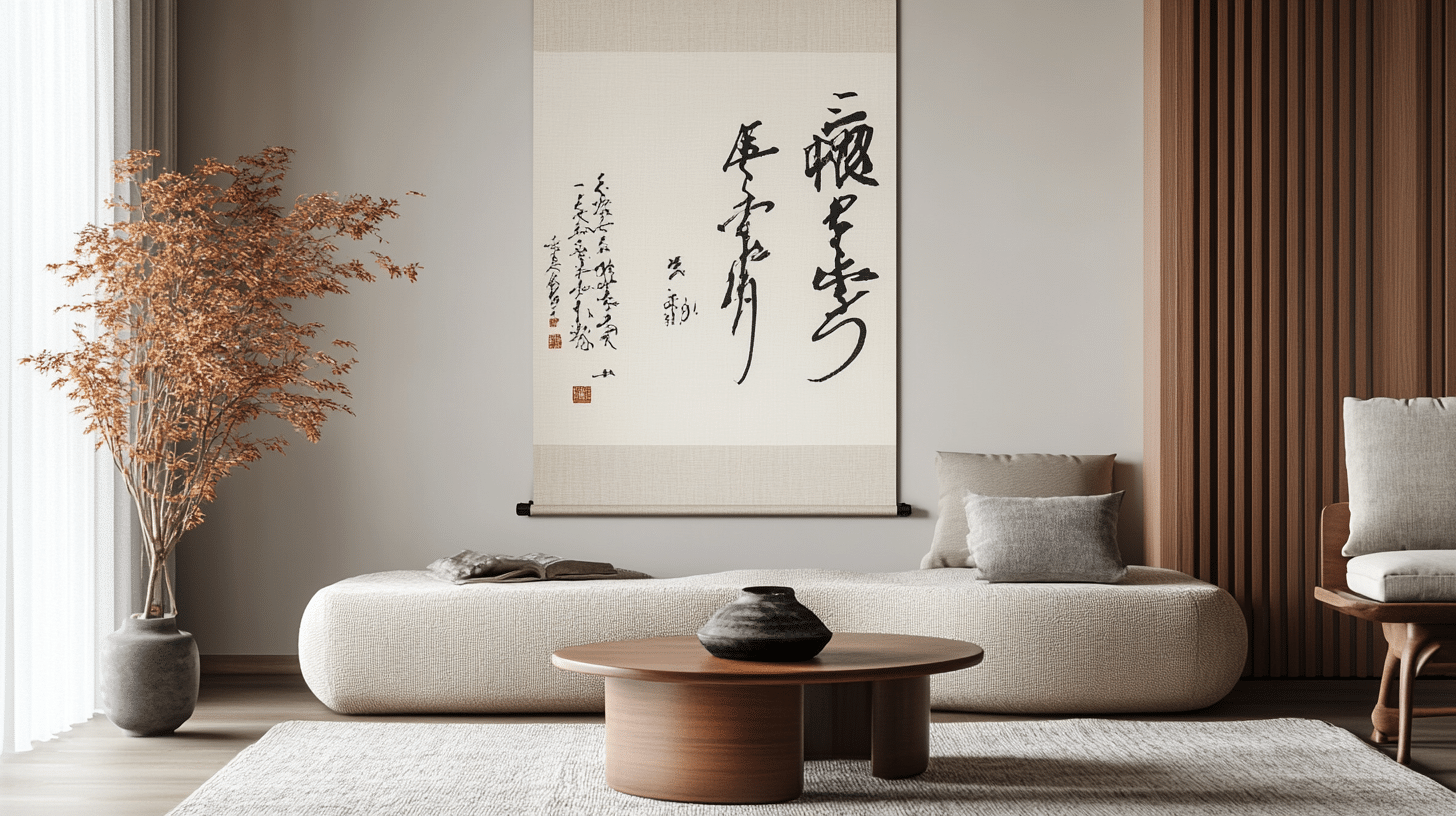
Add elegance and cultural significance with kakejiku scrolls. These hanging scrolls typically feature calligraphy, paintings, or poetry.
Choose scrolls with themes that resonate with you – perhaps a seasonal landscape or an inspiring phrase. Hang them in a prominent spot, like above a low table or in an alcove.
- DIY Idea: Paint or print your own art on fabric and mount it on wooden dowels
- Budget-Friendly Tip: Use decorative tea towels or scarves as makeshift scrolls
- Styling Tip: Hang scrolls at different heights to create visual interest on a wall
24. Fusuma Sliding Doors
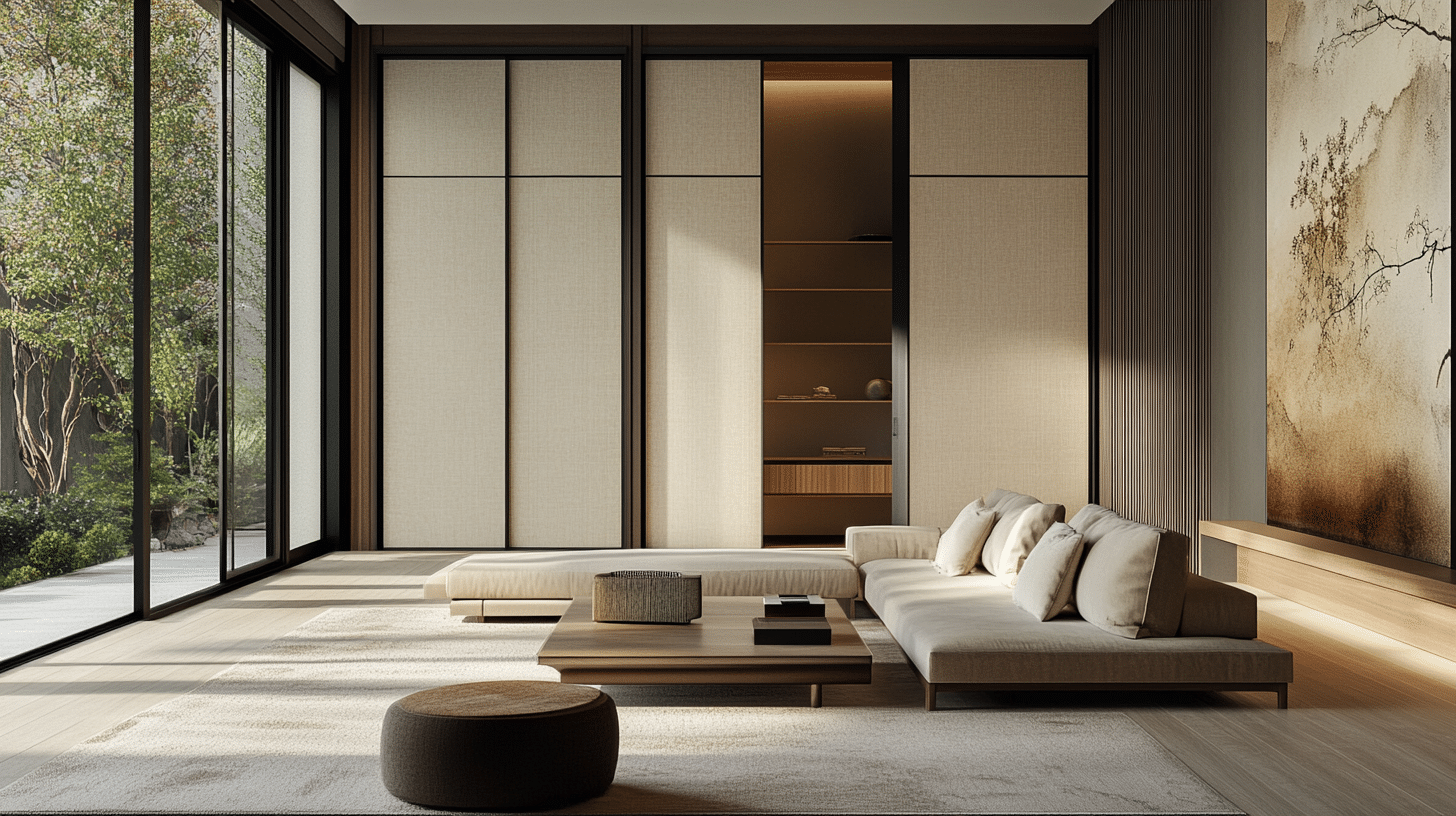
Use fusuma sliding doors to create flexible living spaces. These traditional Japanese room dividers can separate areas or open them up as needed.
They’re great for hiding storage areas or creating a temporary guest room. Fusuma doors slide on tracks, making them easy to operate and space-efficient.
- DIY Idea: Convert existing doors to sliding ones using a basic track system
- Budget-Friendly Tip: Use tension rods and light fabric panels for a similar effect
- Styling Tip: Choose subtle, nature-inspired patterns to maintain a serene atmosphere
25. Water Fountain
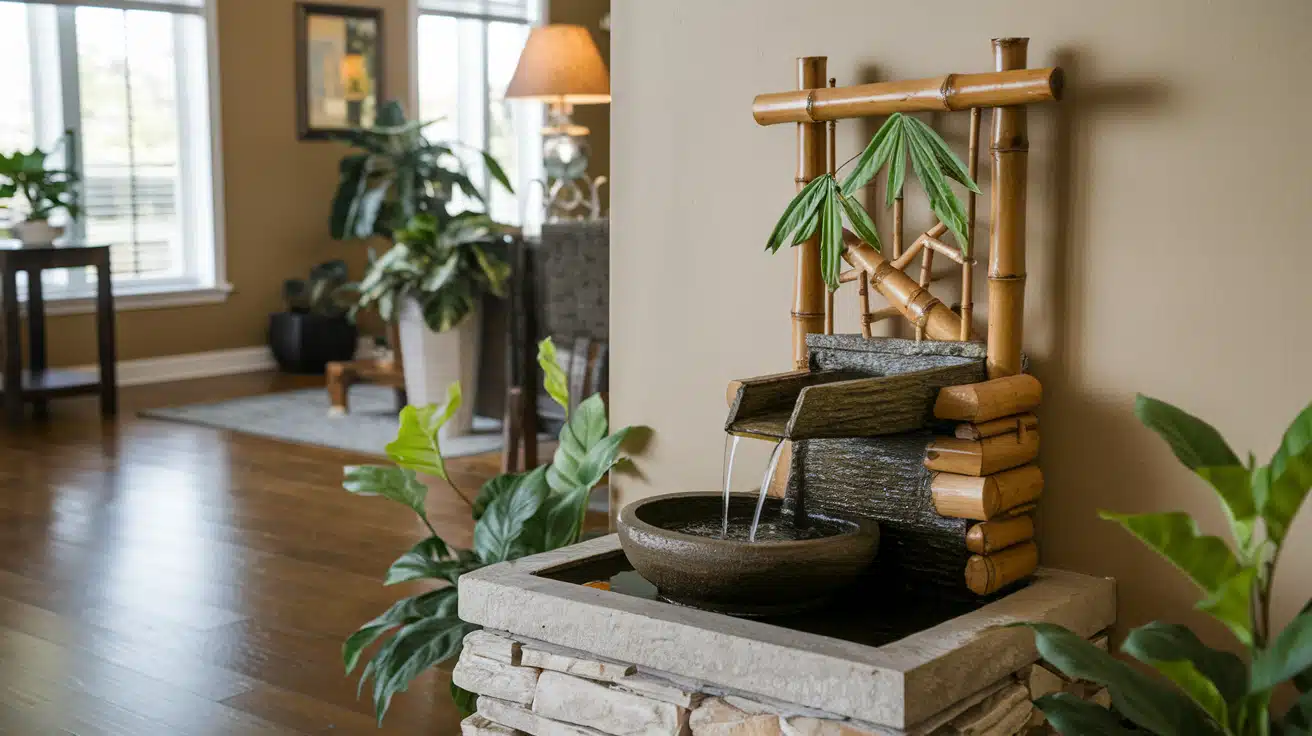
A small indoor water fountain can bring tranquility to your living room. The gentle sound of flowing water helps create a calming atmosphere, reducing stress and promoting relaxation.
Choose a compact design that fits your space, such as a tabletop model or a wall-mounted option. Look for fountains made from natural materials like stone or bamboo to complement your Japanese-inspired decor.
- DIY Idea: Create a tabletop fountain using a shallow bowl, small pump, and smooth stones
- Budget-Friendly Tip: Use a pre-made solar-powered fountain for easy setup and energy savings
- Styling Tip: Surround the fountain with small plants or moss for a natural, zen-like setting
Japanese Living Room Makeover: Your Step-by-Step Guide
- Clear the space: Remove all furniture and decor to start with a blank canvas.
- Plan your layout: Sketch a minimalist floor plan focusing on open space and low-profile furniture placement.
- Prepare the floors: If possible, install tatami mats or use tatami-inspired area rugs.
- Choose your color scheme: Select a neutral palette with earthy tones as your base.
- Install shoji screens or room dividers: Use these to define spaces and add privacy.
- Add low-profile seating: Introduce a low sofa, floor cushions, or zaisu chairs.
- Bring in natural elements: Place potted plants or a small indoor bamboo garden.
- Set up a chabudai: Position a low table as a central piece for dining or tea ceremonies.
- Incorporate storage solutions: Use built-in cabinets or low-shelving units to maintain a clutter-free space.
- Install appropriate lighting: Hang paper lanterns or washi paper lamps for soft illumination.
- Add a focal point: Choose a large calligraphy piece or landscape painting for one wall.
- Introduce natural textures: Use bamboo blinds or linen curtains for windows.
- Set up a tokonoma-inspired space: Designate an alcove for displaying art or ikebana.
- Bring in small accents: Add ceramic vases, a traditional tea set, or wood carvings as decorative elements.
- Create ambiance with scent: Use a subtle incense or essential oil diffuser with traditional Japanese fragrances.
Approximate Cost Breakdown for a Japanese-Inspired Living Room
Here’s a table that provides an approximate cost breakdown for transforming your living room into a Japanese-inspired space.
| Item | Approximate Cost (USD) |
|---|---|
| Tatami Mats | $100 – $500 (per mat) |
| Low Sofa | $300 – $1,500 |
| Zabuton Cushions | $20 – $50 (per cushion) |
| Zaisu Chairs | $50 – $150 (per chair) |
| Chabudai Table | $100 – $400 |
| Shoji Screens | $100 – $400 |
| Washi Paper Lamps | $30 – $150 |
| Paper Lanterns | $20 – $100 |
| Bonsai Tree | $30 – $200 |
| Indoor Plants | $20 – $100 |
| Small Water Fountain | $50 – $200 |
| Kakejiku Scroll | $50 – $300 |
| Ikebana Arrangement | $20 – $100 |
| Ceramics | $30 – $200 |
| Sliding Fusuma Doors | $300 – $1,000 (per door) |
Total Estimated Cost:
Low range: $1,220
High range: $5,450
This range will depend on the materials you choose and the size of the space you’re transforming. You can mix and match elements to stay within your desired budget.
Wrapping It Up
Let’s wrap up our journey through Japanese living room design. We’ve explored 25 key elements and provided a step-by-step guide to help you create a space that embodies tranquility and balance.
Remember, the goal is to craft a living area that speaks to you. Choose elements that resonate with your lifestyle and preferences.
Start small if you’re unsure – perhaps with a low table or a shoji screen – and gradually incorporate more features as you become comfortable with the style.
The beauty of Japanese design lies in its simplicity and connection to nature.
By applying these principles, you can create a living room that’s not just visually appealing, but also a calming retreat from the outside world.
Ready to begin your Japanese-inspired makeover? Take that first step today!
Frequently Asked Questions
What is a Japanese Living Room Called?
A traditional Japanese living room is called a “washitsu.” It typically features tatami mat flooring, sliding doors (fusuma or shoji), and minimal furniture, creating a versatile space for various activities.
Why do Japanese Homes have Tatami Rooms?
Tatami rooms are culturally significant in Japan. They provide a versatile space for sleeping, dining, and relaxation. Today, many modern homes include a tatami room to maintain a connection with traditional Japanese lifestyle and aesthetics.
How Can I Incorporate Technology without Disrupting the Aesthetic?
To blend technology with Japanese aesthetics, use hidden storage solutions for electronics. Choose minimalist designs for visible devices. Wireless options reduce cable clutter. Consider built-in speakers and projectors for a cleaner look.
What Colors are Most Commonly Used in Japanese Interiors?
Japanese interiors often use neutral and earthy tones. Common colors include soft whites, beige, warm browns, and muted greens.

